News & Announcements
- Details
- Written by Roel van Pagée, Joke Henskens-Reijman
Joke Henskens-Reijman and Roel van Pagée, principals, Terra College, The Hague, Netherlands, speak of their encouraging experiences implementing restorative practices in two large, urban secondary schools where the ethnic make up has recently changed from a homogeneous Dutch population to one that includes children from multiple ethnic and national backgrounds. The paper was presented at the first in a series of three IIRP conferences with the theme, "Building a Global Alliance for Restorative Practices and Family Empowerment," in Veldhoven, Netherlands, August 28-30, 2003.
- Details
- Written by Karin Gunderson
Karin Gunderson, of the Northwest Institute for Children and Families, University of Washington School of Social Work, Seattle, Washington, U.S.A, reports the positive results of two significant studies on family group conferencing (FGC): "Long Term and Immediate Outcomes of Family Group Conferencing in Washington State," June 2000, and "''Connected and Cared for'': Family Group Conferencing for Youth in Care," June 2002. The paper was presented at the first in a series of three IIRP conferences with the theme, "Building a Global Alliance for Restorative Practices and Family Empowerment," in Veldhoven, Netherlands, August 28-30, 2003.
- Details
- Written by Lode Walgrave
Lode Walgrave, of Katholieke Universiteit Leuven, Belgium, speaks about the Belgian juvenile justice initiative, which has addressed serious juvenile offenses, including arson, carjacking, armed robbery, serious physical violence and aggravated theft, using the New Zealand model of family group conferencing (FGC), with cases referred by youth court judges. The paper was presented at the first in a series of three IIRP conferences with the theme, "Building a Global Alliance for Restorative Practices and Family Empowerment," in Veldhoven, Netherlands, August 28-30, 2003.
- Details
- Written by Paul McCold, Ted Wachtel
This paper by Paul McCold and Ted Wachtel presents a concise summary of the restorative justice theory that the IIRP has promulgated over the last several years. The theory provides the framework for a comprehensive answer to the how, what and who of the restorative justice paradigm. The paper was presented by Paul McCold at the XIII World Congress of Criminology, August 10-15, 2003, Rio de Janeiro, Brazil. Also available in Portuguese and Spanish languages.
- Details
- Written by Paul McCold
Paper presented at the XIII World Congress of Criminology,
10-15 August 2003, Rio de Janeiro.
Restorative justice is a new way of looking at criminal justice that focuses on repairing the harm done to people and relationships rather than on punishing offenders. Originating in the 1970s as mediation between victims and offenders, in the 1990s restorative justice broadened to include communities of care as well, with victims’ and offenders’ families and friends participating in collaborative processes called “conferences” and “circles.” This new focus on healing and the related empowerment of those affected by a crime seems to have great potential for enhancing social cohesion in our increasingly disconnected societies. Restorative justice and its emerging practices constitute a promising new area of study for social science.
In this paper, we propose a conceptual theory of restorative justice so that social scientists may test these theoretical concepts and their validity in explaining and predicting the effects of restorative justice practices. The foundational postulate of restorative justice is that crime harms people and relationships and that justice requires the healing of the harm as much as possible. Out of this basic premise arise key questions: who is harmed, what are their needs and how can those needs be met?
A CONCEPTUAL THEORY OF RESTORATIVE JUSTICE
Restorative justice is a collaborative process involving those most directly affected by a crime, called the “primary stakeholders,” in determining how best to repair the harm caused by the offense. But who are the primary stakeholders in restorative justice and how shall they be involved in the search for justice? Our proposed theory of restorative justice has three distinct but related conceptual structures: the Social Discipline Window (Wachtel, 1997, 2000; Wachtel & McCold, 2000), Stakeholder Roles (McCold, 1996, 2000) and the Restorative Practices Typology (McCold, 2000; McCold & Wachtel, 2002). Each of these, in turn, explains the how, what and who of restorative justice theory.
Social Discipline Window
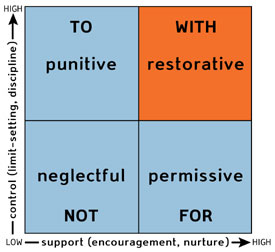 |
|
Figure 1. Social Discipline Window
|
Everyone with an authority role in society faces choices in deciding how to maintain social discipline: parents raising children, teachers in classrooms, employers supervising employees or justice professionals responding to criminal offences. Until recently, Western societies have relied on punishment, usually perceived as the only effective way to discipline those who misbehave or commit crimes.
Punishment and other choices are illustrated by the Social Discipline Window (Figure 1), which is created by combining two continuums: “control,” exercising restraint or directing influence over others, and “support,” nurturing, encouraging or assisting others. For simplicity, the combinations from each of the two continuums are limited to “high” and “low.” Clear limit-setting and diligent enforcement of behavioral standards characterize high social control. Vague or weak behavioral standards and lax or nonexistent regulation of behavior characterize low social control. Active assistance and concern for well-being characterize high social support. Lack of encouragement and minimal provision for physical and emotional needs characterize low social support. By combining a high or low level of control with a high or low level of support the Social Discipline Window defines four approaches to the regulation of behavior: punitive, permissive, neglectful and restorative.
The punitive approach, with high control and low support, is also called “retributive.” It tends to stigmatize people, indelibly marking them with a negative label. The permissive approach, with low control and high support, is also called “rehabilitative” and tends to protect people from experiencing the consequences of their wrongdoing. Low control and low support are simply neglectful, an approach characterized by indifference and passivity.
The restorative approach, with high control and high support, confronts and disapproves of wrongdoing while affirming the intrinsic worth of the offender. The essence of restorative justice is collaborative problem-solving. Restorative practices provide an opportunity for those who have been most affected by an incident to come together to share their feelings, describe how they were affected and develop a plan to repair the harm done or prevent a reoccurrence. The restorative approach is reintegrative, allowing the offender to make amends and shed the offender label.
Four words serve as a shorthand to distinguish the four approaches: NOT, FOR, TO and WITH. If neglectful, one would NOT do anything in response to offending behavior. If permissive, one would do everything FOR the offender, asking little in return and often making excuses for the wrongdoing. If punitive, one would respond by doing things TO the offender, admonishing and punishing, but asking little thoughtful or active involvement of the offender. If restorative, one engages WITH the offender and others, encouraging active and thoughtful involvement from the offender and inviting all others affected by the offense to participate directly in the process of healing and accountability. Cooperative engagement is a critical element of restorative justice.
Stakeholder Roles
 |
|
Figure 2. Stakeholder Roles
|
The second structure of our theory of restorative justice, the Stakeholder Roles (Figure 2), relates the harm caused by the offense to the specific needs of each stakeholder created by that offense, and to the restorative responses required to meet those needs. This causal structure distinguishes the interests of the primary stakeholders—those most affected by a specific offense—from those indirectly affected.
The primary stakeholders are, principally, the victims and offenders, because they are the most directly affected. But those who have a significant emotional connection with a victim or offender, such as parents, spouses, siblings, friends, teachers or co-workers, are also directly affected. They constitute the victims’ and offenders’ communities of care. The harm done, needs created and the restorative responses of primary stakeholders are specific to the particular offense and require active participation to achieve the greatest healing.
The secondary stakeholders include those who live nearby or those who belong to educational, religious, social or business organizations whose area of responsibility or participation includes the place or people affected by the incident. The whole of society, as represented by government officials, is also a secondary stakeholder. The harm to both sets of secondary stakeholders is vicarious and impersonal; their needs are aggregate, not specific, and their most restorative response is to support restorative processes in general.
All primary stakeholders need an opportunity to express their feelings and have a say in how to repair the harm. Victims are harmed by the loss of control they experience as a result of the offense. They need to regain a sense of personal power. This empowerment is what transforms victims into survivors. Offenders damage their relationships with their own communities of care by betraying trust. To regain that trust, they need to be empowered to take responsibility for their wrongdoing. Their communities of care meet their needs by ensuring that something is done about the incident, that its wrongfulness is acknowledged, that constructive steps are taken to prevent further offending and that victims and offenders are reintegrated into their respective communities.
The secondary stakeholders, those who are not emotionally connected to the specific victims and offenders, must not steal the conflict from those to whom it belongs by interfering with the opportunity for healing and reconciliation. The most restorative response for the secondary stakeholders is to support and facilitate processes in which the primary stakeholders determine for themselves the outcome of the case. Such processes will reintegrate both victims and offenders and simultaneously strengthen civil society by enhancing social cohesion and empowering and improving the citizenry’s ability to solve its own problems.
Restorative Practices Typology
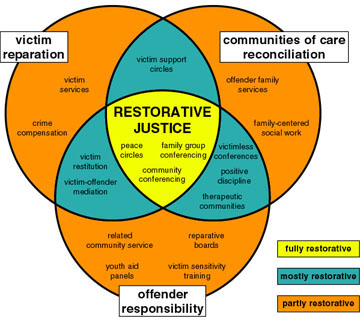 |
|
Figure 3. Restorative Practices Typology
|
Restorative justice is a process involving the primary stakeholders in determining how best to repair the harm done by an offense. The three primary stakeholders in restorative justice are victims, offenders and their communities of care, whose needs are, respectively, getting reparation, taking responsibility and achieving reconciliation. The degree to which all three are involved in meaningful emotional exchange and decision-making is the degree to which any form of social discipline can be termed fully “restorative.” These three sets of primary stakeholders are represented by the three overlapping circles in Figure 3. The very process of interacting is critical to meeting stakeholders’ emotional needs. The emotional exchange necessary for meeting the needs of all those directly affected cannot occur with only one set of stakeholders participating. The most restorative processes involve the active participation of all three sets of primary stakeholders.
When criminal justice practices involve only one group of primary stakeholders, as in the case of governmental financial compensation for victims, the process can only be called “partly restorative.” When a process such as victim-offender mediation includes two principal stakeholders but excludes their communities of care, the process is “mostly restorative.” Only when all three sets of primary stakeholders are actively involved, such as in conferences or circles, is a process “fully restorative.”
CONCLUSION
Crimes harm people and relationships. Justice requires that harm be repaired as much as possible. Restorative justice is not done because it is deserved, but because it is needed. Restorative justice is ideally achieved through a cooperative process involving all the primary stakeholders in determining how best to repair the harm done by the offense.
The conceptual theory presented here provides the framework for a comprehensive answer to the how, what and who of the restorative justice paradigm. The Social Discipline Window describes how conflict can be transformed into cooperation. The Stakeholder Roles structure demonstrates that repair of the emotional and relational harm necessitates the empowerment of the primary stakeholders, those most directly affected. The Restorative Practices Typology demonstrates why participation of the victims, offenders and their communities of care are all required to repair the harm caused by the criminal act.
A criminal justice system that merely doles out punishment to offenders and sidelines victims does not address the emotional or relational needs of those who have been affected by crime. In a world where people feel increasingly alienated, restorative justice restores and builds positive feelings and relationships. A restorative criminal justice system aims not just to reduce crime, but to reduce the impact of crime as well. The capacity of restorative justice to address these emotional and relational needs and engage the citizenry in doing so is the key to achieving and sustaining a healthy civil society.
REFERENCES
McCold, P. (1996). Restorative justice and the role of community. In B. Galaway & J. Hudson (Eds.), Restorative Justice: International Perspectives (pp. 85-102). Monsey, NY: Criminal Justice Press.
McCold, P. (2000). Toward a mid-range theory of restorative criminal justice: A reply to the Maximalist model. Contemporary Justice Review, 3(4), 357-414.
McCold, P., & Wachtel, T. (2002). Restorative justice theory validation. In E. Weitekamp and H-J. Kerner (Eds.), Restorative Justice: Theoretical Foundations (pp. 110-142). Devon, UK: Willan Publishing.
Wachtel, T. (1997). Real Justice: How to Revolutionize our Response to Wrongdoing. Pipersville, PA: Piper’s Press.
Wachtel, T. (2000). Restorative practices with high-risk youth. In G. Burford & J. Hudson (Eds.), Family Group Conferencing: New Directions in Community Centered Child & Family Practice (pp. 86-92). Hawthorne, NY: Aldine de Gruyter.
Wachtel, T., & McCold, P. (2000). Restorative justice in everyday life. In J. Braithwaite and H. Strang (Eds.), Restorative Justice in Civil Society (pp. 117-125). New York: Cambridge University Press.
- Details
- Written by Paul McCold
Ponencia presentada en el XIII Congreso Mundial sobre Criminología,
del 10 al 15 de agosto de 2003, en Rîo de Janeiro.
La justicia restaurativa es una nueva manera de considerar a la justicia penal la cual se concentra en reparar el daño causado a las personas y a las relaciones más que en castigar a los delincuentes. La justicia restaurativa surgió en la década de los años 70 como una forma de mediación entre víctimas y delincuentes y en la década de los años 90 amplió su alcance para incluir también a las comunidades de apoyo, con la participación de familiares y amigos de las víctimas y los delincuentes en procedimientos de colaboración denominados “reuniones de restauración” y “círculos.” Este nuevo enfoque en el proceso de subsanación para las personas afectadas por un delito y la obtención de control personal asociado parece tener un gran potencial para optimizar la cohesión social en nuestras sociedades cada vez más indiferentes. La justicia restaurativa y sus prácticas emergentes constituyen una nueva y promisoria área de estudio para las ciencias sociales.
En la presente ponencia, proponemos una teoría conceptual sobre la justicia restaurativa para que los científicos sociales puedan evaluar estos conceptos teóricos y su validez para explicar y predecir los resultados de las prácticas de justicia restaurativa. El postulado fundamental de la justicia restaurativa es que el delito perjudica a las personas y las relaciones y que la justicia necesita la mayor subsanación del daño posible. De esta premisa básica surgen preguntas clave: ¿quién es el perjudicado, cuáles son sus necesidades y cómo se pueden satisfacer dichas necesidades?
UNA TEORÍA CONCEPTUAL SOBRE JUSTICIA RESTAURATIVA
La justicia restaurativa es un proceso de colaboración que involucra a las “partes interesadas primarias,” es decir, a las personas afectadas de forma más directa por un delito, en la determinación de la mejor manera de reparar el daño causado por el delito. Pero, ¿quiénes son las partes interesadas primarias en la justicia restaurativa y cómo deben participar en la búsqueda de la justicia? La teoría de justicia restaurativa que proponemos cuenta con tres estructuras conceptuales distintas pero relacionadas: la Ventana de la disciplina social (Wachtel 1997, 2000; Wachtel & McCold 2000), la Función de las partes interesadas (McCold 1996, 2000), y la Tipología de las prácticas restaurativas (McCold 2000; McCold & Wachtel, 2002). Cada una de ellas, a su vez, explica el cómo, qué y quién de la teoría de justicia restaurativa.
Ventana de la disciplina social
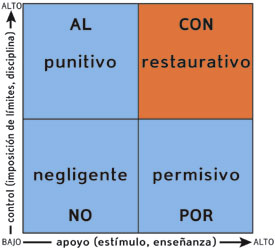 |
|
Figura 1. Ventana de la disciplina social
|
Toda persona en la sociedad con un papel que suponga autoridad enfrenta opciones al decidir cómo mantener la disciplina social: los padres que educan a sus hijos, los maestros en las aulas, los empleadores que supervisan a los empleados o los profesionales de la justicia que actúan ante los delitos. Hasta hace poco las sociedades occidentales se basaban en el castigo, generalmente percibido como la única manera eficaz de disciplinar a aquellas personas que proceden mal o cometen un delito.
El castigo y otras opciones están ilustrados en la Ventana de la disciplina social (Figura 1), la cual se genera mediante la combinación de dos secuencias: “control,” imponer limitaciones o ejercer influencia sobre otros, y “apoyo,” enseñar, estimular o asistir a otros. Por razones de simplicidad, las combinaciones de cada una de las dos secuencias se limitan a “alto” y “bajo.” Un control social alto se caracteriza por la imposición de límites bien definidos y el pronto cumplimiento de los principios conductuales. Un control social bajo se caracteriza por principios conductuales imprecisos o débiles y normas de conducta poco estrictas o inexistentes. Un apoyo social alto se caracteriza por la asistencia activa y el interés por el bienestar. Un apoyo social bajo se caracteriza por la falta de estímulo y la mínima consideración por las necesidades físicas y emocionales. Mediante la combinación de un nivel alto o bajo de control con un nivel alto o bajo de apoyo la Ventana de la disciplina social define cuatro enfoques para la reglamentación de la conducta: punitivo, permisivo, negligente y restaurativo.
El enfoque punitivo, con control alto y apoyo bajo, se denomina también “retributivo.” Tiende a estigmatizar a las personas, marcándolas indeleblemente con una etiqueta negativa. El enfoque permisivo, con control bajo y apoyo alto, se denomina también “rehabilitativo” y tiende a proteger a las personas para que no sufran las consecuencias de sus delitos. Un control bajo y un apoyo bajo son simplemente negligentes, un enfoque caracterizado por la indeferencia y la pasividad.
El enfoque restaurativo, con control alto y apoyo alto, confronta y desaprueba los delitos al tiempo que ratifica el valor intrínseco de los delincuentes. La esencia de la justicia restaurativa es la resolución de problemas de manera colaboradora. Las prácticas restaurativas brindan una oportunidad para que aquellas personas que se hayan visto más afectadas por un incidente se reúnan para compartir sus sentimientos, describir cómo se han visto afectadas y desarrollar un plan para reparar el daño causado o evitar que ocurra nuevamente. El enfoque restaurativo es reintegrativo y permite que el delincuente se rectifique y se quite la etiqueta de delincuente.
Cuatro palabras sirven como referencia para distinguir los cuatro enfoques: NO, POR, AL y CON. Si el enfoque es negligente, NO se hará nada en respuesta a la conducta delictiva. Si es permisivo, se hará todo POR el delincuente, pidiendo poco a cambio y a menudo tratando de justificar el delito. Si es punitivo, se responderá haciéndole algo AL delincuente, amonestándolo y castigándolo, pero esperando poca participación reflexiva o activa por parte del delincuente. Si es restaurativo, se comprometerá CON el delincuente y otras personas, fomentando una participación activa y reflexiva por parte del delincuente e invitando a todas aquellas personas afectadas por el delito a participar directamente en el proceso de subsanación y de aceptación de responsabilidad. El compromiso cooperativo es un elemento fundamental de la justicia restaurativa.
Función de las partes interesadas.
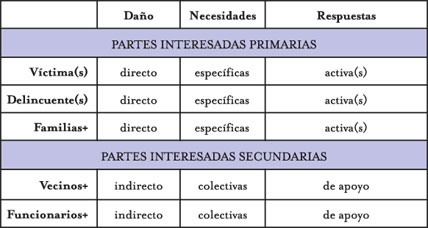 |
|
Figura 2. Función de las partes interesadas
|
La segunda estructura de nuestra teoría de justicia restaurativa, las Funciones de las partes interesadas (Figura 2), relaciona el daño ocasionado por el delito con las necesidades específicas de cada parte interesada que surgieron a partir de dicho delito y con las respuestas restaurativas necesarias para satisfacer dichas necesidades. Esta estructura causal diferencia los intereses de las partes interesadas primarias -aquellas personas más afectadas por un delito específico- de los de las personas indirectamente afectadas.
Las partes interesadas primarias son, principalmente, las víctimas y los delincuentes puesto que son las partes más afectadas directamente. Pero aquellos que tienen una conexión afectiva importante con la víctima o el delincuente, como por ejemplo, padres, cónyuges, hermanos, amigos, maestros o compañeros de trabajo, también se ven directamente afectados. Ellos constituyen las comunidades de apoyo de las víctimas y los delincuentes. El daño ocasionado, las necesidades creadas y las respuestas restaurativas de las partes interesadas primarias son específicas del delito en particular y exigen una participación activa para lograr el mayor nivel de subsanación.
Las partes interesadas secundarias incluyen a aquellas personas que viven cerca o a aquellas que pertenecen a organizaciones educativas, religiosas, sociales o comerciales cuya área de responsabilidad o participación abarca el lugar o las personas afectadas por el incidente. Toda la sociedad, representada por funcionarios del gobierno, constituye también una parte interesada secundaria. El daño causado a ambos grupos de partes interesadas secundarias es indirecto e impersonal, sus necesidades son colectivas e inespecíficas, y su mayor respuesta restaurativa es apoyar los procedimientos restaurativos en general.
Todas las partes interesadas primarias necesitan una oportunidad para expresar sus sentimientos y participar en la decisión sobre la manera de reparar el daño. Las víctimas se ven perjudicadas por la pérdida de control que sufren como consecuencia del delito. Necesitan recuperar un sentido de dominio personal. Esta obtención de control personal es lo que transforma a las víctimas en sobrevivientes. Los delincuentes dañan sus relaciones con sus propias comunidades de apoyo traicionando la confianza. Para recobrar esa confianza, necesitan obtener control personal para asumir la responsabilidad por el delito cometido. Sus comunidades de apoyo satisfacen sus necesidades asegurando que se haga algo con respecto al incidente, que se reconozca su carácter erróneo, que se tomen medidas constructivas para evitar que ocurran otros delitos y que las víctimas y los delincuentes se reintegren en sus respectivas comunidades.
Las partes interesadas secundarias, aquellas personas que no se encuentran emocionalmente vinculadas a las víctimas o los delincuentes específicos, no deben despojar del conflicto a aquellos a quienes les pertenece interfiriendo en la oportunidad de subsanación y reconciliación. La respuesta más restaurativa para las partes interesadas secundarias es apoyar y facilitar los procedimientos en los que las partes interesadas primarias deciden por ellas mismas el resultado del caso. Dichos procedimientos reinsertarán a las víctimas y los delincuentes y al mismo tiempo fortalecerán a la sociedad civil mediante la optimización de la cohesión social y la obtención de control personal y mejoramiento de la capacidad de los ciudadanos para resolver sus propios problemas.
Tipología de las prácticas restaurativas
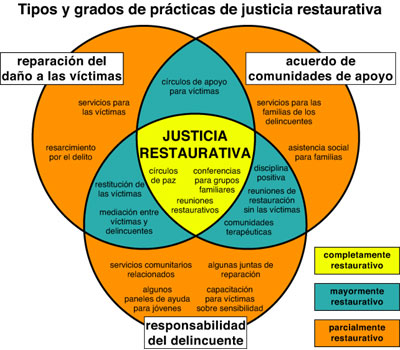 |
|
Figura 3. Tipología de las prácticas restaurativas
|
La justicia restaurativa es un proceso que involucra a las partes interesadas primarias en la decisión sobre la mejor manera de reparar el daño ocasionado por un delito. Las tres partes interesadas primarias en la justicia restaurativa son las víctimas, los delincuentes y sus comunidades de apoyo, cuyas necesidades son, respectivamente, lograr la reparación del daño, asumir la responsabilidad y llegar a un acuerdo. El grado en que las tres partes participan en intercambios emocionales significativos y la toma de decisiones es el grado según el cual toda forma de disciplina social puede ser calificada como completamente “restaurativa.” Estos tres grupos de partes interesadas primarias están representados por tres círculos superpuestos en la Figura 3. El propio proceso de interacción es fundamental para satisfacer las necesidades emocionales de las partes interesadas. El intercambio emocional necesario para satisfacer las necesidades de todas aquellas personas directamente afectadas no puede tener lugar con la participación de un solo grupo de partes interesadas. Los procesos más restaurativos incluyen la participación activa de los tres grupos de partes interesadas primarias.
Cuando las prácticas de la justicia penal incluyen sólo a un grupo de partes interesadas primarias, como en el caso del resarcimiento económico para las víctimas por parte del gobierno, el proceso sólo se puede llamar “parcialmente restaurativo.” Cuando un procedimiento como el de mediación entre víctimas y delincuentes incluye dos partes interesadas principales pero excluye a las comunidades de apoyo, el proceso es “mayormente restaurativo.” El proceso es “completamente restaurativo” sólo cuando los tres grupos de partes interesadas primarias participan activamente, como por ejemplo en reuniones de restauración o círculos.
CONCLUSIÓN
Los delitos dañan a las personas y las relaciones. La justicia exige que el daño se repare tanto como sea posible. La justicia restaurativa no se aplica porque es merecida, sino porque es necesaria. La justicia restaurativa se logra de manera ideal mediante un proceso cooperativo que involucra a todas las partes interesadas primarias en la decisión sobre la mejor manera de reparar el daño ocasionado por el delito.
La teoría conceptual aquí presentada proporciona el marco para una respuesta global al cómo, qué y quién del paradigma de justicia restaurativa. La Ventana de la disciplina social describe la manera en que el conflicto se puede transformar en colaboración. La estructura de las Funciones de las partes interesadas demuestra que la reparación del daño emocional y relacional requiere la obtención de control personal de las partes interesadas primarias, aquellas personas afectadas de forma más directa. La Tipología de las prácticas restaurativas demuestra el motivo por el cual la participación de las víctimas, los delincuentes y sus comunidades de apoyo es necesaria para reparar el daño causado por el acto delictivo.
Un sistema de justicia penal que solamente imparte castigos a los delincuentes y excluye a las víctimas no encara las necesidades emocionales y relacionales de aquellas personas que se vieron afectadas por el delito. En un mundo donde las personas se sienten cada vez más alienadas, la justicia restaurativa restablece y desarrolla sentimientos y relaciones positivos. Un sistema restaurativo de justicia penal apunta no sólo a reducir la cantidad de delitos, sino también a disminuir el impacto de los mismos. La capacidad de la justicia restaurativa de tratar estas necesidades emocionales y relacionales y de comprometer a los ciudadanos en el proceso es la clave para lograr y mantener una sociedad civil sana.
REFERENCIAS BIBLIOGRÁFICAS
McCold, P. (1996). Restorative justice and the role of community [La justicia restaurativa y la función de la comunidad]. En B. Galaway & J. Hudson (Eds.) Restorative Justice: International Perspectives (pp. 85-102). Monsey, NY: Criminal Justice Press.
McCold, P. (2000). Toward a mid-range theory of restorative criminal justice: A reply to the Maximalist model [Hacia una teoría de justicia restaurativa penal de alcance intermedio: Una respuesta al modelo Maximalista]. Contemporary Justice Review, 3(4), 357-414.
McCold, P., & Wachtel, T. (2002). Restorative justice theory validation [Validación de la teoría de justicia restaurativa]. En E. Weitekamp and H-J. Kerner (Eds.), Restorative Justice: Theoretical Foundations (pp. 110-142). Devon, UK: Willan Publishing.
Wachtel, T. (1997). Real Justice: How to Revolutionize our Response to Wrongdoing [La justicia verdadera: Cómo cambiar radicalmente nuestra respuesta ante los delitos]. Pipersville, PA: Piper’s Press.
Wachtel. T. (2000). Restorative practices with high-risk youth [Prácticas restaurativas con jóvenes de alto riesgo]. En G. Burford & J. Hudson (Eds.). Family Group Conferencing: New Directions in Community Centered Child & Family Practice (pp. 86-92). Hawthorne, NY: Aldine de Gruyter.
Wachtel, T., & McCold, P. (2000). Restorative justice in everyday life [La justicia restaurativa en la vida diaria]. En J. Braithwaite and H. Strang (Eds.), Restorative Justice in Civil Society (pp. 117-125). New York: Cambridge University Press.
- Details
- Written by Paul McCold
Trabalho apresentado no XIII Congresso Mundial de Criminologia,
10-15 Agosto de 2003, Rio de Janeiro.
A justiça restaurativa é uma nova maneira de abordar a justiça penal, que enfoca a reparação dos danos causados às pessoas e relacionamentos, ao invés de punir os transgressores. Tendo se originado nos anos 70 como uma mediação entre vítimas e transgressores, nos anos 90 a justiça restaurativa foi ampliada para incluir comunidades de assistência, com as famílias e amigos das vítimas e transgressores participando de processos colaborativos denominados “conferências” e “círculos”. Este novo enfoque na resolução de conflitos e o conseqüente fortalecimento daqueles afetados por uma transgressão parecem ter o potencial de aumentar a coesão social nas nossas sociedades, cada vez mais distantes umas das outras. A justiça restaurativa e suas práticas emergentes constituem uma nova e promissora área de estudo das ciências sociais.
Nesse trabalho propomos uma teoria conceptual de justiça restaurativa para que os cientistas sociais possam por à prova estes conceitos teóricos e sua validade na explicação e prognóstico das práticas de justiça restaurativa. O postulado fundamental da justiça restaurativa é que o crime causa danos às pessoas e relacionamentos e que a justiça exige que o dano seja reduzido ao mínimo possível. Dessa premissa resultam as seguintes questões chave: Quem foi prejudicado? Quais as suas necessidades? Como atender a essas necessidades?
UMA TEORIA CONCEPTUAL DE JUSTIÇA RESTAURATIVA
A justiça restaurativa é um processo colaborativo que envolve aqueles afetados mais diretamente por um crime, chamados de “partes interessadas principais”, para determinar qual a melhor forma de reparar o dano causado pela transgressão. Mas quem são as principais partes interessadas na justiça restaurativa e como devem se comprometer na busca pela justiça? Nossa proposta teoria de justiça restaurativa é composta de três estruturas conceituais distintas, porém relacionadas: Social Discipline Window - A Janela de Disciplina Social (Wachtel 1997, 2000; Wachtel & McCold 2000), Stakeholder Roles - O Papel das Partes Interessadas (McCold 1996, 2000) e Restorative Practices Typology - A Tipologia das Práticas Restaurativas (McCold 2000; McCold & Wachtel, 2002). Cada uma dessas explica o como, o por quê e o quem da teoria de justiça restaurativa.
A Janela de Disciplina Social
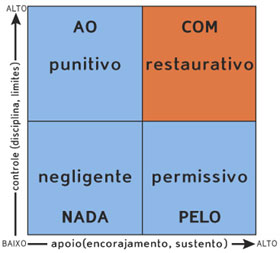 |
|
Figura 1. Janela de Disciplina Social
|
Todos aqueles que têm um cargo de autoridade na sociedade precisam tomar decisões sobre como manter a disciplina social: pais criando filhos, professores em salas de aula, empregadores supervisionando empregados ou profissionais da justiça respondendo a transgressões penais. Até pouco tempo, as sociedades ocidentais vinham utilizando punições, normalmente vistas como a única forma eficiente de disciplinar aqueles que se comportavam mal ou cometiam crimes.
Punição e outras opções estão ilustradas na Janela de Disciplina Social (Figura 1), que é criada pela combinação de dois continuums: “controle”, que limita ou influencia os outros, e “apoio”, cuidando, encorajando ou assistindo outros. Para simplificar, as combinações de cada um desses continuums foram limitadas a “alto” e “baixo”. A delimitação clara de limites e a imposição diligente de padrões de comportamento caracterizam um alto grau de controle social. Padrões vagos ou fracos de comportamento e regulamentos permissivos ou inexistentes caracterizam um baixo controle social. A assistência ativa e preocupação pelo bem-estar coletivo caracterizam o alto apoio social. A falta de encorajamento e uma provisão mínima para necessidades físicas e emocionais caracterizam o baixo apoio social. Combinando um nível alto ou baixo de controle com um nível alto ou baixo de apoio, a Janela de Disciplina Social define quatro abordagens à regulamentação do comportamento: punitiva, permissiva, negligente e restaurativa.
A abordagem punitiva, com alto controle e baixo apoio, também chamada de “retributiva”, tende a estigmatizar as pessoas rotulando-as indelevelmente de forma negativa. A abordagem permissiva, com baixo controle e alto apoio, também chamada “reabilitadora”, tende a proteger as pessoas das conseqüências de suas ações erradas. Baixo controle e baixo apoio são simplesmente negligentes, uma abordagem caracterizada pela indiferença e passividade.
A abordagem restaurativa, com alto controle e alto apoio, confronta e desaprova as transgressões enquanto afirmando o valor intrínseco do transgressor. A essência da justiça restaurativa é a resolução de problemas de forma colaborativa. Práticas restaurativas proporcionam, àqueles que foram prejudicados por um incidente, a oportunidade de reunião para expressar seus sentimentos, descrever como foram afetados e desenvolver um plano para reparar os danos ou evitar que aconteça de novo. A abordagem restaurativa é reintegradora e permite que o transgressor repare danos e não seja mais visto como tal.
Quatro palavras descrevem resumidamente as abordagens: NADA, PELO, AO e COM. Se negligente, NADA faz em resposta a uma transgressão. Se permissiva, tudo faz PELO (por o) transgressor, pedindo pouco em troca e criando desculpas para as transgressões. Se punitiva, as respostas são reações AO transgressor, punindo e reprovando, mas permitindo pouco envolvimento ponderado e ativo do mesmo. Se restaurativa, o transgressor encontra-se envolvido COM o transgressor e outras pessoas prejudicadas, encorajando um envolvimento consciente e ativo do transgressor, convidando outros lesados pela transgressão a participarem diretamente do processo de reparação e prestação de contas. O engajamento cooperativo é elemento essencial da justiça restaurativa.
O Papel das Partes Interessadas
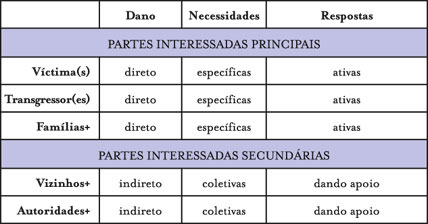 |
|
Figura 2. Papéis das Partes Interessadas
|
A segunda estrutura de nossa teoria de justiça restaurativa, o papel das partes interessadas (Figura 2), relaciona o dano causado pela transgressão às necessidades específicas de cada parte interessada resultantes da mesma, e às respostas restaurativas necessárias ao atendimento destas necessidades. Essa estrutura causal distingue os interesses das partes interessadas principais—aqueles mais afetados pela transgressão—dos afetados indiretamente.
As partes interessadas principais são principalmente constituídas pelas vítimas e os transgressores porque são os mais diretamente afetados. No entanto, aqueles que têm uma relação emocional significativa com uma vítima ou transgressor, como os pais, esposos, irmãos, amigos, professores ou colegas, também são considerados diretamente afetados. Eles constituem as comunidades de assistência a vítimas e transgressores. O dano causado, as necessidades criadas e as atitudes restaurativas das partes interessadas principais são próprias de cada transgressão e precisam de participação ativa da comunidade para alcançar reparação máxima.
As partes interessadas secundárias (indiretas) incluem os vizinhos, aqueles que pertencem a organizações religiosas, educacionais, sociais ou empresas cujas áreas de responsabilidade incluem os lugares ou as pessoas afetadas pela transgressão. A sociedade como um todo, representada pelo governo, também é uma parte interessada secundária. O dano causado às duas partes interessadas secundárias é indireto e impessoal, suas necessidades são coletivas, não específicas, e sua resposta máxima é apoiar os processos restaurativos como um todo.
Todas partes interessadas principais precisam de uma oportunidade para expressar seus sentimentos e ter uma voz ativa no processo de reparação do dano. As vítimas são prejudicadas pela falta de controle que sentem em conseqüência da transgressão. Elas precisam readquirir seu sentimento de poder pessoal. Esse fortalecimento é o que transforma as vítimas em sobreviventes. Os transgressores prejudicam seu relacionamento com suas comunidades de assistência ao trair a confiança das mesmas. Para recriar essa confiança eles devem ser fortalecidos para poderem assumir responsabilidade por suas más ações. Suas comunidades de assistência preenchem suas necessidades garantindo que algo será feito sobre o incidente, que tomarão conhecimento do ato errado, que serão tomadas medidas para coibir novas transgressões e que vítimas e transgressores serão reintegrados às suas comunidades.
As partes interessadas secundárias, que não estão ligadas emocionalmente às vítimas e transgressores, não devem tomar para si o conflito daqueles a quem pertence, interferindo na oportunidade de reconciliação e reparação. A resposta restaurativa máxima para as partes interessadas secundárias deve ser a de apoiar e facilitar os processos em que as próprias partes interessadas principais determinam o que deve ser feito. Estes processos reintegrarão vítimas e transgressores, fortalecendo a comunidade, aumentando a coesão e fortalecendo e ampliando a capacidade dos cidadãos de solucionar seus próprios problemas.
Tipologia das Práticas Restaurativas
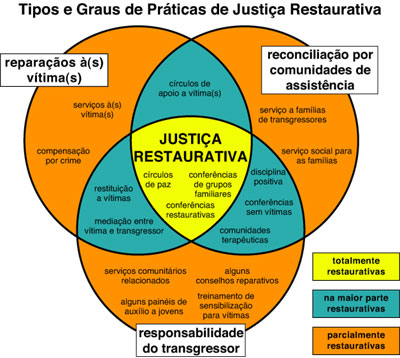 |
|
Figura 3. Tipologia das Práticas Restaurativas
|
A justiça restaurativa é um processo que envolve as partes interessadas principais na decisão de como reparar o dano causado por uma transgressão. As três partes interessadas principais na justiça restaurativa são as vítimas, os transgressores e suas comunidades de assistência, cujas necessidades são, respectivamente: obter a reparação, assumir a responsabilidade e conseguir a reconciliação. O grau de envolvimento das três numa troca emocional e decisões significativas determinará o grau em que qualquer forma de disciplina social poderá ser chamada apropriadamente de “restaurativa”. Esses três grupos de partes interessadas principais são representados pelos três círculos da Figura 3. O próprio processo de interação é crítico para preencher as necessidades emocionais das partes interessadas. O compartilhamento de emoções necessário para atingir os objetivos de todos os que foram diretamente afetados não pode ocorrer através de participação unilateral. O mais restaurativo dos processos requer a participação ativa dos três grupos.
Quando as práticas da justiça penal envolvem apenas um dos grupos de partes interessadas principais, como no caso de compensação financeira do governo às vitimas, o processo só pode ser chamado de “parcialmente restaurativo”. Quando a vítima e o transgressor participam de um processo de mediação sem a participação de suas comunidades, esse será “na maior parte restaurativo”. Apenas quando os três grupos participam ativamente, como em conferências ou círculos, pode ser dito que o processo é “totalmente restaurativo”.
CONCLUSÃO
Crimes causam danos a pessoas e relacionamentos. A justiça requer que o dano seja reparado ao máximo. A justiça restaurativa não é feita porque é merecida e sim porque é necessária. A justiça restaurativa é conseguida idealmente através de um processo cooperativo que envolve todas as partes interessadas principais na determinação da melhor solução para reparar o dano causado pela transgressão.
A teoria conceptual apresentada possibilita uma resposta abrangente que explica o como, o por quê e o quem do paradigma da justiça restaurativa. A Janela de Disciplina Social explica como o conflito pode se transformar em cooperação. A Estrutura de Papéis das Partes Interessadas Principais mostra que para reparar os danos aos sentimentos e relações requer o fortalecimento das partes interessadas principais, afetadas de forma mais direta. A Tipologia das Praticas Restaurativas explica porque a participação da vítima, do transgressor e das comunidades é necessária à reparação do dano causado pelo ato criminoso.
Um sistema de justiça penal que simplesmente pune os transgressores e desconsidera as vítimas não leva em consideração as necessidades emocionais e sociais daqueles afetados por um crime. Em um mundo onde as pessoas sentem-se cada vez mais alienadas, a justiça restaurativa procura restaurar sentimentos e relacionamentos positivos. O sistema de justiça restaurativa tem como objetivo não apenas reduzir a criminalidade, mas também o impacto dos crimes sobre os cidadãos. A capacidade da justiça restaurativa de preencher essas necessidades emocionais e de relacionamento é o ponto chave para a obtenção e manutenção de uma sociedade civil saudável.
REFERÊNCIAS BIBLIOGRÁFICAS
McCold, P. (1996). Restorative justice and the role of community. In B. Galaway & J. Hudson (Eds.), Restorative Justice: International Perspectives (pp. 85-102). Monsey, NY: Criminal Justice Press.
McCold, P. (2000). Toward a mid-range theory of restorative criminal justice: A reply to the Maximalist model. Contemporary Justice Review, 3(4), 357-414.
McCold, P., & Wachtel, T. (2002). Restorative justice theory validation. In E. Weitekamp and H-J. Kerner (Eds.), Restorative Justice: Theoretical Foundations (pp. 110-142). Devon, UK: Willan Publishing.
Wachtel, T. (1997). Real Justice: How to Revolutionize our Response to Wrongdoing. Pipersville, PA: Piper’s Press.
Wachtel. T. (2000). Restorative practices with high-risk youth. In G. Burford & J. Hudson (Eds.). Family Group Conferencing: New Directions in Community Centered Child & Family Practice (pp. 86-92). Hawthorne, NY: Aldine de Gruyter.
Wachtel, T., & McCold, P. (2000). Restorative justice in everyday life. In J. Braithwaite and H. Strang (Eds.), Restorative Justice in Civil Society (pp. 117-125). New York: Cambridge University Press.
- Details
- Written by United Kingdom Home Office
The United Kingdom Home Office published this document (PDF) outlining a strategy for implementing restorative justice in the criminal justice system. The strategy has two elements: (1) to build in high-quality restorative justice at all stages of the UK criminal justice system and (2) to develop understanding of where restorative justice works best and how it could be fully integrated with the justice system in the longer term.
- Details
- Written by Tim Newell
From a speech by Tim Newell
Tim Newell worked for the Prison Service in England for 37 years. He recently retired after ten years as the governor of Grendon and Spring Hill prisons. As governor, he avoided the often punitive and stigmatizing practices of typical prisons. Instead, he created a therapeutic community environment that incorporated principles of restorative practices. The following is from his plenary speech at the IIRP’s Third International Conference in August 2002. In this speech he discussed his experience building these model prison communities, prison culture and how restorative practitioners can overcome institutional resistance.
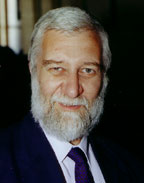 |
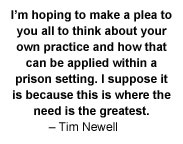 |
My first experience with restorative work was actually as a victim. I was living onsite of a young offender establishment. I had been in the job a couple of years and my bachelor home was burglarized by one of the offenders. We were able to quickly establish who it was. In discussing with Barry why he had done it, he said that he was quite interested in getting into a home setting and was interested particularly in my home. Being a bachelor and being at the start of a job, my home was rather sparse. He was unfortunately not well rewarded by the experience. Most young offender establishments have a culture that puts quite an emphasis on personal cleanliness and tidiness. One of the interesting things in the dialogue with Barry was some fairly strong advice he gave me on how to tidy my place up.
I celebrate the work that is taking place at present within prisons. They are demanding places to work in and are very challenging environments in which to introduce some of the ideas we’ve been hearing about at this conference. Over the years, one of the questions I would regularly be asked was, “Why aren’t there more Grendons?” It really is a unique environment where the culture is very different from other prisons. The predominance of fear that dominates most prison settings was by-and-large removed over a period of time through the involvement of and the trust that developed between some very heavy offenders. Half of the 250 prisoners are life sentence prisoners, murderers, rapists and serious offenders. How is it that this culture is not spread to other prisons?
Sadly, prisons are often lacking in hope for the future. If I were a prisoner, I would not be too optimistic about my chances, given the reconviction rates we are dealing with. For young offenders in England, we’re looking at a return to court at 85 to 90 percent within two years of being released. For adults, we are looking at 55 to 60 percent returning to court and a conviction within two years of release. It’s currently something like £35,000 in England to keep someone in for a year. It’s extremely expensive. We now have over 72,000 people, which goes up every week and every month.
Given that the values of restorative work are in conflict with the experience of imprisonment, why do we work in prisons? Why am I asking that we try to focus our work much more in that area? I’m hoping to make a plea to you all to think about your own practice and how that can be applied within a prison setting. I suppose it is because this is where the need is and where the need is the greatest.
The picture that is often presented to me is that it is hard working in prisons. There are the restorative champions who have a lot of information and a lot of skills that they are bringing with them. They work hard to try to move people and ideas. There are often many observers just watching to see what will happen and quite often it feels as though there are a lot of people who are obstructing. This resistance is not personal. It is a dynamic. It’s a dynamic that comes from within the organization. We’ll look at ways in which, perhaps, it is possible to get through some of this obstruction.
I will try to answer a question that was put to me recently. I was at a conference looking at the work of the Thames Valley Police. The assistant chief constable was sitting next to me and handed me a card which read, “Why is it so hard to move the mainstream of the criminal justice system from doing things we know don’t work to doing things we know do?” I expect that’s a question many of us have been asked over the years. He asked me to email him an answer. I’m still working on it. I started doing something about it.
Let’s look at prison culture and values. Obviously, the security role is predominant within most prison cultures. Also, there is a strong subculture of prisoner secrecy and distance from staff. In order to survive, there is secrecy and subculture development. The prison culture is dominated by risk avoidance because sometimes the risks are considered to be far too high. The political pressure is on to try to avoid taking too many risks and avoid making too many mistakes. There is a very hierarchical structure within the prison setting.
In contrast, Grendon had a very clear prime objective. Therapy was its purpose. Men came there to seek to understand themselves and resolve aspects of their past behavior in exploring their current behavior. The treatment ethic was dominant. Everybody was involved in it, including prison officers, people who worked in the administrative departments and myself as governor. I was accountable. I’ve had several interesting sessions in which I was called down to community meetings to explain decisions that I’ve made and give an account as to why things happened in a certain way. The considerable social distance between staff and prisoners was very greatly reduced in order to actually carry out this work.
People were seen very much as equals within the setting. All staff and all prisoners were regarded as therapists. In a therapeutic community, that’s the role everybody takes on. You don’t have experts. You don’t have individual work. You work very much as a community. Whenever there was an issue or a problem, the mantra was, “Take it to your group.” You don’t resolve it in private. You resolve it in public. The ethos of the management was to actually manage risk because the treatment was dependent upon allowing people to make mistakes and establish wider boundaries for their own behavior.
 The staff structure was extremely flat. We tried to ensure that as many decisions as possible were made within the communities where the staff was working directly with prisoners. So there were very few decision-making committees within the establishment. One of the key things was that the process was important. Everything that was done was done within an inclusive process so everybody was involved. There was an openness about decisions even when pretty horrible decisions had to be made, such as people being moved on or programs being shut down for lack of finance.
The staff structure was extremely flat. We tried to ensure that as many decisions as possible were made within the communities where the staff was working directly with prisoners. So there were very few decision-making committees within the establishment. One of the key things was that the process was important. Everything that was done was done within an inclusive process so everybody was involved. There was an openness about decisions even when pretty horrible decisions had to be made, such as people being moved on or programs being shut down for lack of finance.
Within that environment, Grendon was able to work. This is in contrast to other prisons. We were able to maintain the work because it was effective. We certainly had the lowest escape rate in England. We had the lowest assault rate of all prisons. Also, we had the highest involvement of prisoners in programs: 100 percent in Grendon. The staff were committed to the regime and practice, so there were no industrial relations issues at all in that environment. All prisoners looked after each other in terms of suicide prevention, so we were able to survive that as well. There was a long waiting list of prisoners wanting to come to the place. We had twice as many people on our waiting list as places in the prison. The reputation spread amongst prisoners that this was the place where they could actually achieve some understanding of themselves and perhaps some capacity to move on and not cause further damage.
Obviously, victims of those people who are in prison are often those most seriously affected by crime. The offenders have been the most damaging people. From my experience working with some of the most damaging people, they are also the most damaged people. Part of what needs to happen in prison is that personal experience of damage should be explored within that setting. I suppose it’s the one advantage of a prison setting. You have people, you are containing them and you can offer them choices and chances. You can do some work with them within a boundary. That’s one of the real advantages.
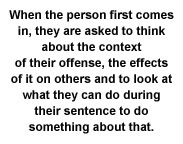 The communities of those people who are in prison are often the most relieved that the person is now behind the wall. But they are often the most anxious about what’s going to happen when this person returns and how that person is likely to behave. The context in which the offense occurred and the effects of the offense are very rarely considered within the prison setting. Before I retired, I was fortunate to have a short period doing some work in three other prisons. We worked with a group of staff within those prisons to look at the functions with which you could use restorative processes. In Winchester, Bristol and Norwich prisons we are working with the whole approach towards sentence management and sentence planning. So when the person first comes in, they are asked to think about the context of their offense, the effects of it on others and to look at what they can do during their sentence to do something about that.
The communities of those people who are in prison are often the most relieved that the person is now behind the wall. But they are often the most anxious about what’s going to happen when this person returns and how that person is likely to behave. The context in which the offense occurred and the effects of the offense are very rarely considered within the prison setting. Before I retired, I was fortunate to have a short period doing some work in three other prisons. We worked with a group of staff within those prisons to look at the functions with which you could use restorative processes. In Winchester, Bristol and Norwich prisons we are working with the whole approach towards sentence management and sentence planning. So when the person first comes in, they are asked to think about the context of their offense, the effects of it on others and to look at what they can do during their sentence to do something about that.
We are working with the anti-bullying policy and the race relations policy. We are working with the adjudications or infractions policy. Instead of going through a formal adjudication process where the warden is the judge and jury and gives the sentence, we suspend all of that and have a circle to determine what should happen as a result of an assault or other anti-social behavior within a prison context. Those are some of the things that are happening within those three prisons now.
There is a major project taking place in England and Wales at present, in the Thames Valley. It is a big research project based in a metropolitan area. It involves about five big prisons, particularly in the Thames Valley, which includes a prison named Bullingdon. There are formal conferences taking place with serious, violent adult offenders. The Home Office has funded it.
There was some concern that the work within Bullingdon prison was taking place without any incentive at all. Prisoners do not get parole or shorter sentences, just offered the opportunity [to participate in a conference]. Out of the 150 or so who fell into this category, about 130 have taken up the offer of doing it. They have now had over 50 conferences in the prison within the last nine months or so, which is really a roller coaster approach, I’m afraid. It’s going very fast. There has been a lot of staff trained to do it, including prison guards facilitating conferences. The effect upon the culture at Bullingdon is something we are looking forward to examining.
In a place called Brinsford, a young offender establishment, there is some very imaginative mediation work taking place between victims in the community and young offenders within the establishment. This includes face-to-face meetings, but more often includes reports, letters or videotapes that are sent in order to try and help both parties understand what happened.
The other aspect is the application of restorative principles to the whole prison. I suppose a place like Grendon would be seen as a totally different cultural approach where the whole prison is accountable and tries to work to a different set of values. We established a core team of prison officers and other staff, a multidisciplinary team. We did some awareness training for all prison staff. We did an audit of all the processes, which produced an action plan that we then prioritized. We have some allies now on the restorative side who are pushing a bit. The obstructers are getting a bit weaker and the observers are jumping off the fence. Since last year, another prison has opened with the same principles. It is called Dovegate. There are other people doing this sort of work, individually motivated, who have to carve out space, protocols and safety to carry out their practice. They have an uphill struggle every time they seek to make this sort of intervention.
The big challenge that is coming up is how do we seek to use this approach with the Headquarters and how do we try to help politicians and mandarins to work in a restorative way. There are some openings coming up. The Home Office is very concerned and is trying to reduce victim dissatisfaction. There are no strategies yet as to how that is going to be done, but one of the key things already coming out of the research from Bullingdon and the Thames Valley is how strongly victims feel committed to the process and how much they have gained from it.
Why is it so hard? The resistance is not a personal thing. I think it’s an organizational thing, it’s a dynamic thing and it’s a cultural thing. Because of the very unusual nature of the work, prisons have evolved a culture, a paradigm and a mindset that determines the way they do the things they have to do. This is a brief look at a model that is more fully described in my paper “Restorative Practice in Prisons: Circles and Conferencing in the Custodial Setting.” (To read this paper go to: www.iirp.edu/article_detail.php?article_id=NDQ1.)
What I would suggest is that we look at using the model to think about the six factors that focus on the paradigm in any organization you’re working in [see below]. I don’t think it just relates to prisons. I think every organization has this cultural web and the structure that supports it. Most consultants go for the easy ones—control systems, power structures and organizational structures—because they are more readily accessible. The important thing for us, I think, is to focus on the subconscious areas: the stories, symbols and rituals. Through that, one can assess the nature of the paradigm and look to develop our own stories, of which we have a massive amount. Our stories, our symbols and our rituals can help the organization meet its needs.
Obviously, stories are vitally important in any culture. What we say to each other and others about how we celebrate or denigrate what happens can determine how we feel about the place. The symbols we have, such as name badges, are important. The simple things that we use within prison settings. The symbolic use of names is vitally important. The director general saw that in private prisons in England, staff refers to prisoners as Mr., Miss or Mrs. So-and-so. Whereas in the public sector prisons, they are always referred to purely by their second or surname. He asked us all to think about how we could change that. The resistance to that has been tremendous and so deeply emotional that it obviously represents a serious symbol that will be difficult to shift.
Rituals and routines are vitally important as well within the subconscious of the culture. What rites of passage are there within the organization: rites of celebration, rites of degradation, rites of challenge and rites of counterchallenge? Paradigms are in the middle of this, which is what is being protected.
 I hope I’ve provided some ideas on how we can get through this resistance and how we can work to change the current state of prisons and our dependency upon them. What I would like to close with is to ask that you consider within your own practice the possibility of moving some of that into a prison setting: either to help people towards their release or to involve yourself during their time in the prison. I see this as the most serious arena for our work. It’s life and death matters that we are considering within prisons.
I hope I’ve provided some ideas on how we can get through this resistance and how we can work to change the current state of prisons and our dependency upon them. What I would like to close with is to ask that you consider within your own practice the possibility of moving some of that into a prison setting: either to help people towards their release or to involve yourself during their time in the prison. I see this as the most serious arena for our work. It’s life and death matters that we are considering within prisons.
I would like to end with some silence. But before the silence I would like to quote something that epitomizes how serious the need for restorative practice is in our society. This is from an English novelist, Ian McEwan, who wrote in The Guardian on the 13th of September last year [2001].
“If the hijackers had been able to imagine themselves into the thoughts and feelings of the passengers, they would have been unable to proceed. It is hard to be cruel once you permit yourself to enter the mind of your victim. Imagining what it is like to be someone other than yourself is at the core of our humanity. It is the essence of compassion and it is the beginning of morality.”
 Excerpted from “Restorative Practice in Prisons: Circles and Conferencing in the Custodial Setting” by Tim Newell. In considering the application of restorative ideas in prisons, we could use the model of the cultural web. Through this we could audit the way in which changes are already taking place in some prisons and how more could be achieved through this methodical approach towards cultural change. Restorative practitioners are beginning to work more in prisons and this effort could be considered through the model of the cultural web so that the work is effective within the context of the project but also in affecting the wider prison community. The way that some of this work has been approached has influenced the functional areas of work described below. This work has been achieved by prison staff being dissatisfied with traditional ways of operating and realising that through restorative practice a more satisfactory process could be developed with more just outcomes. Through audit and developing practice it is possible to see there are opportunities in the following areas of functional activity in prisons: Induction programmes for prisoners. Establishing norms through staff and peer tuition and example, through setting standards and developing expectations of taking responsibility during the sentence can be very effective at the start of the sentence when prisoners are often at their most sensitive and receptive. Complaints and requests systems. The requests and complaints of prisoners can be considered through an open process of mediation and direct communication in order to establish what happened, who was affected, in what way and what should be done to put things right. This can be in contrast to some current practice that is often secretive in process and unsatisfactory in outcome for all parties. Adjudications. Disciplinary hearings form a critical focus of many prison systems. How infractions of the rules are considered by the prison sets the tone of staff attitudes and prisoner compliance in many prisons. To offer an alternative process of a circle is a dramatic way to express the concept of staff and prisoners working together to resolve conflicts rather than reacting to them stereotypically. This process can be seen to gain a win-win setting, rather than the inevitable win-lose one of blame and scapegoating. (Continued on next page.) Race relations. Similar handling of equal opportunity issues through open ways of mutual respect can establish for staff and prisoners that such matters are taken seriously. Their concerns will be handled fairly and openly whenever possible, recognising the perceived victim’s feelings and willingness for such a process. Anti-violence strategy. The same considerations apply as for the anti-bullying strategy. The strategy to be developed could well include training for staff and prisoners in conflict-resolution awareness and skills, perhaps through a programme like the AVP (Alternatives to Violence Project). The establishing of peer mediators, as with the ‘listeners’ programme for suicide prevention and the peer education-tutoring scheme, will play to the strengths of many prisoners in managing difficult settings and in being able to support each other. Preparation for release. When sentence planning is done in partnership with prisoners many restorative justice possibilities arise for accepting responsibility for the crime, establishing some accountability for the future to victims, primary and secondary, and a commitment to the community to which prisoners will return. The resources of the prison—work, education, leisure, offending behaviour courses and other programmes—can be channeled to this effect. Victim empathy and accountability for criminal behaviour are expressed in these programmes in which prisoners take responsibility for their behaviour. This is the ideal setting for voluntary compliance, honesty and contrition to be expressed. Resettlement. Preparation for resettlement should start early in the sentence and should engage the agencies that are likely to be affected by the prisoner’s release, such as housing, health and employment, as well as the criminal justice agencies of police and probation. On home leave or temporary release from prison, offer the possibility of a conferencing of agencies, including justice ones, with the prison providing some feedback about the course of the sentence and about future expectations. Family and victims could be involved in this process that is focused on the issues of returning to the community. Circles on release. Once released, the prisoner often experiences difficulties in sustaining the plans and the intentions when in custody. There is sometimes a need to provide some community support and involvement through a formal Circle of Support and Accountability. Prison Outreach. Staff and prisoners can serve the community by educating groups about the effect of imprisonment through the sharing of information about prisons and about the life stories of offenders. Staffing processes. In order to integrate restorative justice practices, principles and processes into the prison’s life it is important that prison staff feel that they are treated with the same respect and consideration. Thus, dispute and conflict resolution procedures should be developed offering mediation and conferencing for staff with trained facilitators. The personnel management of staff should operate with the same principles of concern for the individual and the respect for their personal development within the professional setting. |
- Details
- Written by Laura Mirsky
Part one in this series can be read at: http://restorativeworks.net/?p=1506.
Part two in this series can be read at: http://restorativeworks.net/?p=1504.
 |
 |
This is the third and final part in a series about family group conferencing (FGC), a restorative process that empowers families to make decisions, usually made for them by outside officials, concerning the care and support of their children and other family members. FGC began in New Zealand and has spread throughout the world. The key features of the New Zealand FGC model, where it is built into child welfare law, are preparation, information giving, private family time, agreeing on the plan and monitoring and review. In North America there is a growing use of the term Family Group Decision Making (FGDM). Part one of this series mainly emphasized FGC in child welfare and contained a brief explanation and history of FGC. In addition to other child welfare FGC programs, parts two and three address FGCs in adult mental health, youth justice and school applications, as well as FGC theory and philosophy.
Northern Ireland, specifically Tyrone and Armagh counties, is the site of a unique project in that it encompasses both child welfare family group conferences (FGC) and restorative school group conferences. The latter is using conferences in schools based on the Real Justice model (an IIRP program: www.realjustice.org). Both the FGC and school conferencing projects are partnerships between two statutory agencies—the Southern Education and Library Board and the Southern Health and Social Services Board—and Diamond House, a project of Barnardos, an NGO. Barnardos is the largest children’s charity in the UK, servicing England, Scotland, Wales and Northern Ireland, plus the Republic of Ireland. It provides family support, foster placements and FGC and works with children with disabilities, teen mothers, young people who are abused and in domestic violence cases. The Barnardos website is www.barnardos.org.uk/index.jsp.
The FGC and school conferencing pilot projects began in April 2000 and ended in March 2003. Funding from a combination of education and children’s sources has now been obtained to support the projects for three more years. Outcomes of the pilots have generally been positive. In a recent independent evaluation of the work, all the young people who took part in the conferences stated that they would recommend FGC or school conferencing to another young person in a similar situation.
Child welfare FGCs are referred through social services. Marie Gribben, scheme leader of FGC for County Tyrone, said that social services staff members know to refer to FGCs because they received awareness training at the beginning of the project, which has been repeated annually. Child welfare cases referred to FGCs include those where parents are under stress and having difficulty coping with their children. FGCs engage the extended family to help provide a safety net for the child, said Gribben. In three FGCs involving parental death, the extended family offered placements to the children. FGCs have also redirected children being considered for foster care to family placement. Children already in state care have gone back to live with their parents with the support of extended family, or have been placed with extended family or into a shared-care arrangement between foster parents or residential units and extended family members. In the latter cases, a child may remain in state care and spend weekends or other times with extended family. All these arrangements enable family to be more involved in a child’s life, said Gribben.
 The project employs the New Zealand model, with special attention paid to ensuring that the voice of the child is heard, said Gribben. When the FGC project began, the emphasis initially was on engaging the extended family and the child was not the focus. Now, three contacts are made with the child prior to the FGC to learn about her anxieties, needs, dreams and what she would like to happen at the conference and to determine how best to help her share this information. Children of all ages attend the conference and the facilitator supports them at the meeting. “Children have been very vocal and clear about what they want to say,” said Gribben. Children say where they want to live and the reasons why. A child might tell his parents: “I don’t want you to be upset, but I think I’m picking aunt or uncle over you.” Children often express gratitude to people for coming to a conference about them. “It’s fun to hear from them directly,” said Gribben, “and very powerful.”
The project employs the New Zealand model, with special attention paid to ensuring that the voice of the child is heard, said Gribben. When the FGC project began, the emphasis initially was on engaging the extended family and the child was not the focus. Now, three contacts are made with the child prior to the FGC to learn about her anxieties, needs, dreams and what she would like to happen at the conference and to determine how best to help her share this information. Children of all ages attend the conference and the facilitator supports them at the meeting. “Children have been very vocal and clear about what they want to say,” said Gribben. Children say where they want to live and the reasons why. A child might tell his parents: “I don’t want you to be upset, but I think I’m picking aunt or uncle over you.” Children often express gratitude to people for coming to a conference about them. “It’s fun to hear from them directly,” said Gribben, “and very powerful.”
One reason FGC works well in Ireland, said Gribben, is because it mirrors ancient Irish culture. For centuries, Ireland was governed by the Brehon Laws, which allowed that decisions about orphaned children, widows, people with disabilities or those who had committed crimes were to be made by kin (extended family) or clan (a wider group). There are still very strong family links in Ireland, said Gribben, especially in rural areas. County Tyrone, the project locale, is a rural area. But, she said, even in Northern Ireland’s cities, everyone comes from a rural background, two generations back or less.
Gribben noted that FGCs had begun to change the culture of social work in her area. “While 52 conferences have been held, we are becoming continually aware of the ‘systemic impact’ of even introducing the idea of conferencing to families and young people,” she said, adding, “Engagement has in itself led to change and the harnessing of support from family and friends, removing the need for a conference. We are beginning to record these incidents now.” She cited the case of a 13-year-old boy who was sole caregiver for his chronically ill mother and his younger sister. The mother was too proud to ask for help from anyone and the boy was so over-burdened that he attempted suicide. The mother received information and a pamphlet on FGCs explaining the way extended family can help with family problems and took it upon herself to set up a support network within her extended family. A formal FGC never took place.
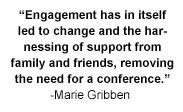 Gribben said that Diamond House was exploring the use of FGC with domestic violence, which has been an issue in a number of child welfare cases. She said they were influenced in this area by the work of Joan Pennell and Gale Burford, co-directors of the FGDM Project in Newfoundland, Labrador and New Brunswick, Canada in the 1990s. This project used an adaptation of New Zealand FGC to reduce domestic violence and by Hampshire County, England’s DOVE domestic violence project, directed by Sharon Inglis. (The DOVE Project will be covered in an upcoming IIRP eForum article focusing exclusively on FGC in Hampshire County.) Gribben also said that Diamond House was examining the use of FGCs with teen mothers, harnessing family support to help them care for their children.
Gribben said that Diamond House was exploring the use of FGC with domestic violence, which has been an issue in a number of child welfare cases. She said they were influenced in this area by the work of Joan Pennell and Gale Burford, co-directors of the FGDM Project in Newfoundland, Labrador and New Brunswick, Canada in the 1990s. This project used an adaptation of New Zealand FGC to reduce domestic violence and by Hampshire County, England’s DOVE domestic violence project, directed by Sharon Inglis. (The DOVE Project will be covered in an upcoming IIRP eForum article focusing exclusively on FGC in Hampshire County.) Gribben also said that Diamond House was examining the use of FGCs with teen mothers, harnessing family support to help them care for their children.
The Diamond House school group conferencing project is coordinated by Cathy McCann, who is an education welfare officer, a school vice principal and a school conference facilitator. Conferencing involves young people taking responsibility for and restoring the harm caused by their actions, said McCann. She said that they were inspired to use the Real Justice model after learning about it at a conference in April, 2000, from IIRP president Ted Wachtel and Terry O’Connell, director of Real Justice Australia, an IIRP program.
First, said McCann, they raised awareness about the pilot in their area. To date, nine schools have put themselves forward to participate. Presentations about the program are delivered to the schools’ entire staffs. “Everyone has to understand the process for it to benefit the kids,” said McCann. Referrals to the program come from education welfare officers (school social workers), other school personnel, non-school social workers and youth diversion officers (police officers who work with youth). “We have a good partnership with all the agencies,” said McCann. Most referrals are for behavioral issues: volatile conduct, bullying, being disrespectful to teachers, verbal assault and truancy. From September 2000 through April 2003, the conferencing program had 69 inquiries, 55 paper referrals, 27 conferences and 16 review conferences. Both Protestant and Catholic students are involved in the project, making it a cross-community endeavor, said McCann.
After a referral has been made, the young person is asked who he or she wants to attend the conference. Because the kids choose whom to invite, they take better ownership of the process, said McCann. Most choose their mother or father and sometimes extended family members and friends. Although McCann makes it clear that it’s preferable for both parents to attend the conference, usually only one parent does, often because the other has to work. Kids are asked if they want their friends to attend, but most choose not to invite them. Friends attending can be a positive element, though, said McCann, adding, “When a peer says, ‘Would you wise up?’ it’s better than adults saying it.” Depending on the case, others may attend, as well, including teachers, school administrators, social workers and youth diversion officers. “We want to deal with things holistically,” said McCann, adding, “It’s important that everyone understands what’s going on.”
McCann does pre-conference preparation, visiting students so that they understand the process and feel comfortable enough to participate and not “just say what they think we want to hear. The child needs to build trust in me,” she said. Conferences are held at school during the school day. The first year, they were held after school, but that wasn’t convenient for the teachers, said McCann.
In the conference, people are invited to sit in a circle, with the offender and the victim on either side of McCann and their supporters beside them, and are asked restorative questions: who was affected and how, how they feel about it, how to repair the harm. In that way, the students get to understand that their actions have an effect on people other than themselves, said McCann. There are no freeloaders at the meeting, she said, adding, “If a child can bear his soul, everyone else can too.” Toward the end of the conference, everyone comes up with a plan for how to prevent wrongdoing in the future and the child has to approve it. Future support for the child from professionals and parents is ensured at the conference. “If a kid is not getting support at home in some way, they’re not going to improve,” she said.
McCann told a story of a 16-year-old boy who had verbally threatened a teacher, been suspended from school several times and was about to be expelled unless he agreed to attend a conference. He had been an offered one once before and had declined. He asked McCann if he really had to have a conference. The process is voluntary, so she told him: You have a choice, but it’s limited—you can either have a conference or be expelled. He chose the conference because he wanted to take his exams.
 McCann discovered that the boy found it difficult to talk and that he was afraid he wouldn’t be able to get the right words out in the conference. She told him to write down the questions and answers so he wouldn’t forget them. He was prepared to say that he was sorry, that he felt guilty, that he never would have really hurt his teacher. At the meeting, the boy never needed to refer to his paper with the questions. He was articulate and made eye contact. He was back in school in two days. Two months later, he’s still doing fine. Afterwards, the boy’s school principal said that he couldn’t believe he was the same person. Said McCann: “He needed to hear: ‘You can do it,’ rather than ‘We don’t want you here.’” Another 12-year-old had also been suspended several times. In the conference he heard his father say—for the first time—that he was proud of him. At the end of the conference when the boy was asked what had surprised him about the meeting, he said, “That my daddy could be proud of me.” This is very powerful stuff, said McCann.
McCann discovered that the boy found it difficult to talk and that he was afraid he wouldn’t be able to get the right words out in the conference. She told him to write down the questions and answers so he wouldn’t forget them. He was prepared to say that he was sorry, that he felt guilty, that he never would have really hurt his teacher. At the meeting, the boy never needed to refer to his paper with the questions. He was articulate and made eye contact. He was back in school in two days. Two months later, he’s still doing fine. Afterwards, the boy’s school principal said that he couldn’t believe he was the same person. Said McCann: “He needed to hear: ‘You can do it,’ rather than ‘We don’t want you here.’” Another 12-year-old had also been suspended several times. In the conference he heard his father say—for the first time—that he was proud of him. At the end of the conference when the boy was asked what had surprised him about the meeting, he said, “That my daddy could be proud of me.” This is very powerful stuff, said McCann.
The stumbling block to people accepting the idea of conferencing in schools has been the fact that it’s a real change from what they’re used to, said McCann. Now, she said, kids are being maintained within the school system because of the support systems developed in conferences, instead of being expelled. Said McCann: “When you give young people a chance to speak that’s enough to empower them to take responsibility for their actions.” The whole process has to be acknowledged, McCann said, adding, “If I meet with them several times, sometimes they don’t need the conference.” Barnardos is hoping to engage with 70 families and do 25 FGCs and 25 school conferences in Northern Ireland in the coming year.
 In the Republic of Ireland, the FGC and restorative justice conferencing models are being combined in restorative justice initiatives for young offenders. The information below was obtained from a conversation with Kieran O’Dwyer, Head of Research for An Garda S'ochan√جø¬Ω (Ireland’s National Police Service), at the Garda Research Unit, Garda S'ochan√جø¬Ω College, Templemore, County Tipperary, Republic of Ireland. This article also cites a paper addressing an overview of results from evaluations of 83 cases, which O’Dwyer presented at the Second Conference of the European Forum for Victim-Offender Mediation and Restorative Justice, in Oostende, Belgium, October 2002.
In the Republic of Ireland, the FGC and restorative justice conferencing models are being combined in restorative justice initiatives for young offenders. The information below was obtained from a conversation with Kieran O’Dwyer, Head of Research for An Garda S'ochan√جø¬Ω (Ireland’s National Police Service), at the Garda Research Unit, Garda S'ochan√جø¬Ω College, Templemore, County Tipperary, Republic of Ireland. This article also cites a paper addressing an overview of results from evaluations of 83 cases, which O’Dwyer presented at the Second Conference of the European Forum for Victim-Offender Mediation and Restorative Justice, in Oostende, Belgium, October 2002.
A juvenile diversion program has been in operation in Ireland since 1963 without statutory backing, said O’Dwyer. The Children Act 2001 has since provided support for restorative justice interventions, including a police referral provision, which was brought into effect in May 2002. Under the Act, all young offenders who admit responsibility for their criminal behavior must be considered for diversion “unless the interests of society require otherwise.”
Ireland’s youth justice diversion program was inspired by New Zealand youth justice FGCs, but unlike New Zealand’s program, it is entirely voluntary. O’Dwyer considers the voluntary aspect, for both offender and victim, to be critical, as “it helps ensure that the event itself and any agreement it produces are not seen as punishment.” It also helps ensure “positive engagement with the process and commitment to any agreement.” The program operates differently from the New Zealand model in other ways, said O’Dwyer. It is closer to the Thames Valley (UK) restorative conferencing program, he said, but unlike that program, is used only with young people, not adults. (For a research summary about the Thames Valley Police Initiative in Restorative Conferencing, go to: https://www.iirp.edu/images/pdf/thamesvalley.pdf.)
The restorative interventions used in diversion are commonly referred to as either restorative cautions or family conferences. To avoid confusion, said O’Dwyer, the term “restorative police event” is often used. (A police caution is the formal disposal of a criminal case without the involvement of prosecutors or the courts.) A restorative caution includes discussion of the offender’s criminal behavior. After the formal caution “finger-wagging” is done, said O’Dwyer, a conference is a chance to bring people together to focus on a specific occurrence, with an emphasis on drawing up an action plan. In this context, said O’Dwyer, FGC is “not terribly different from restorative conferencing.”
 |
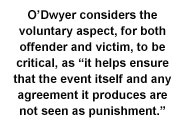 |
In the family conference, the young person is made accountable for his actions, the victim can attend and tell his story, the young person can apologize for the harm he has done and possibly arrange to make reparations, including financial compensation, and an action plan is prepared to prevent a recurrence of offending behavior. Conferences are recommended and facilitated by juvenile liaison officers (JLOs), Gardai (police officers) specially trained to work with young people. JLOs are “the gatekeepers to the Garda system of restorative justice,” said O’Dwyer. They are “not like the real police,” he said, adding, “They’re almost never in uniform and can go into places where others can’t go.” All JLOs are trained in restorative justice. A different JLO facilitates the conference from the one who is supervising the case, to provide distance and protect against the danger that the JLO would try to implement his or her own agenda at the conference.
As in FGC, the conference begins with preparation. “Preparation is everything,” said O’Dwyer. The facilitating JLO visits the family of the youth offender and that of the victim. This is something that needs to be looked at carefully, said O’Dwyer, adding, “We don’t want JLOs making deals” between victims and offenders before the conference about reparation amounts or directing the process too much in other ways, e.g., recommending anger management for offenders. ‘This is not the way it should work,” said O’Dwyer.
Conferences are held in community centers, hotels, sometimes at schools if they’re involved—somewhere everyone feels safe. Conferences used to be held in police stations, said O’Dwyer, but they’re moving away from that now. Conferences are often held in the evening. One advantage to having police as facilitators is that they’re on duty at night, said O’Dwyer. If the victim is young, it’s possible that he or she might not attend the conference, only his or her parents. If either the victim or the offender is under 18 years of age, parents are required by law to be involved. Participation of a large extended family is rare. Usually only a few people from the family attend, said O’Dwyer.
Ground rules are agreed upon at the beginning of the conference, including a requirement to listen to each other respectfully, an assurance that everyone will have a chance to speak and that the proceedings will be confidential. The Real Justice script is used. A conference begins with the facilitator asking the offender: What happened? What were you thinking about at the time? What have you thought about since the incident? Who do you think has been affected by your actions? How have they been affected? Who was affected? The victim is asked: What was your reaction at the time of the incident? How do you feel about what happened? What has been the hardest thing for you? How did your family and friends react when they heard about the incident? The victim’s parents and supporters, and the offender’s parents and supporters are asked similar questions and the offender is asked if he or she has anything else to add. Private family time, as used in the New Zealand model, when the family is left alone to make its own decisions regarding an action plan, is offered, said O’Dwyer, but most people don’t take it.
The key elements of the conference, said O’Dwyer, are an apology from the offender to the victim and a promise not to repeat the offense. The offender must show true remorse, he said. Most action plans tend not be too complicated or ambitious. Reparations, including “onerous duties and obligations” are not usually a feature of action plans, but often service to the victim is included. Plans may involve joining a club, taking part in a special police project, staying in school, going for counseling or paying reparations to the victim. There are rarely over two elements in any plan, said O’Dwyer.
Some very serious offenses have been dealt with successfully in a restorative way, said O’Dwyer. At first, JLOs tried to stay away from conferencing the harder cases but now they are deliberately choosing those cases to conference—such as those involving grievous assault—and some of those conferences are really dramatic and emotional. “At the beginning of the first conference I was a skeptic,” said O’Dwyer, but now he sees conferences as “the most natural way to deal with the harm caused.” In conferences, people see that others have their best interests at heart, he said.
“The restorative justice philosophy fits well with the Garda commitment to giving young offenders a second chance under the Juvenile Diversion Program,” said O’Dwyer. He feels that a significant start was made when restorative justice was introduced on a pilot basis before the enactment of the Children Act, and hopes that the Act will present opportunities to mainstream the restorative approach. O’Dwyer would like to see the process tried to its full potential and envisions much wider implications, including implementation with adults as well as young people.
Olmsted County, Minnesota, USA has been the in the forefront of Family Group Decision Making (FGDM) initiatives. FGDM is part of Minnesota’s Alternative Response program. The Alternative Response program is a strength-based and community-oriented approach to addressing child maltreatment reports that do not meet statutory requirements for a mandated investigative approach, which ensures that children are safe, avoids negative labels for parents, sets aside the issue of fault, works in partnership with parents, identifies families’ needs, provides services and resources matched to those needs and builds on parents’ and communities’ strengths and resources.
 The Olmsted County FGDM project began in 1996. Suzanne Lohrbach is supervisor of Child Protection Services (CPS), Olmsted County Community Services. Lohrbach said that in designing its FGDM program, Olmsted CPS was influenced by the UK Department of Health publication: “Child Protection and Child Abuse: Messages from Research, 1995,” which advocated partnerships between social workers and families as well as collaboration among professionals, as opposed to the traditional, paternalistic approach where professionals talk only to each other and exclude families. Lohrbach said that they look at FGDM as a partnership and at “how to connect that with a family centered practice.”
The Olmsted County FGDM project began in 1996. Suzanne Lohrbach is supervisor of Child Protection Services (CPS), Olmsted County Community Services. Lohrbach said that in designing its FGDM program, Olmsted CPS was influenced by the UK Department of Health publication: “Child Protection and Child Abuse: Messages from Research, 1995,” which advocated partnerships between social workers and families as well as collaboration among professionals, as opposed to the traditional, paternalistic approach where professionals talk only to each other and exclude families. Lohrbach said that they look at FGDM as a partnership and at “how to connect that with a family centered practice.”
Minnesota has 300-plus facilitators trained in FGDM, which is the preferred process in child welfare cases in Olmsted County, said Lohrbach. “Families are told: ‘This is what we do,’ ” she said. If a family objects to the process, a more traditional approach is taken, but it’s much more piecemeal and takes longer. Olmsted CPS has performed satisfaction surveys in which an overwhelming majority of respondents, both families and service providers, found FGDM to be useful and helpful.
FGDM is used in many situations in Olmsted: in early intervention cases, in alternative response safety plans, with juvenile sex offenders, in transition from treatment to foster care, in adolescent independence plans and in TANIFF (Temporary Assistance to Needy Families) cases to decide plans for families when public assistance runs out. Lohrbach’s ultimate vision is of “open community referrals” whereby anyone—related to child welfare or not—may develop an FGDM plan for the care of an elderly relative, a terminally ill parent, a child or others.
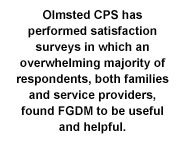 Several different FGDM models are used in Olmsted County, including the New Zealand FGC model, which incorporates private family time, and the Family Unity Meeting (FUM) model, which does not include private family time but stresses devoting time to exploring the family’s strengths and concerns. The decision about which model to use is fleshed out during conference preparation, sometimes based on whether there are enough family members to use private family time, said Lohrbach.
Several different FGDM models are used in Olmsted County, including the New Zealand FGC model, which incorporates private family time, and the Family Unity Meeting (FUM) model, which does not include private family time but stresses devoting time to exploring the family’s strengths and concerns. The decision about which model to use is fleshed out during conference preparation, sometimes based on whether there are enough family members to use private family time, said Lohrbach.
As FUM was the first model introduced in Olmsted, facilitators are accustomed to incorporating strengths and concerns in their meetings, said Lohrbach, but she wondered about the process’s “cultural relevance.” She asked: “Who is it for—the family or the facilitator? Is it designed just to keep a comfortable, positive atmosphere?” She thought that the strengths and concerns segment might cause meetings to lose focus. On the other hand, Lohrbach had concerns about the presentation of facts portion—or information-giving time—in the New Zealand FGC model, asking: “What is that? It could be interpretation, values, what social workers bring with them to the meeting.”
The primary model in use in Minnesota is an FGC hybrid, which both explores strengths and concerns and employs private family time. Lohrbach said that they were trying to return to a “purer” FGC model, one closer to the original model developed in New Zealand. She commented: “It’s okay to do different things but you have to be careful not to blur the models.” Looking at a pure model is important for research purposes, to ensure that the data is meaningful. “The accountability model, the circle process, all these are fine,” she said, but in order to institute good process and practice, you have to know what it is, to be able demonstrate its effectiveness. “If you can’t do that,” she said, “it dies.” Finally, said Lohrbach, “All these new models worry me. I’m not sure we have to keep reinventing the wheel. I hope we never see a Minnesota model of FGDM. We want to have international relevance.”
Lohrbach said she thought it was critical that FGDM be mainstream practice. But, she said, “It can’t be used for everything.” Preparation is essential to determine if there is a decision to be made, and if the social worker or the probation officer is willing to share power with the family. FGDM won’t work if they are not. Because it’s our usual practice at Olmsted CPS, she said, these objections are rare in child welfare.
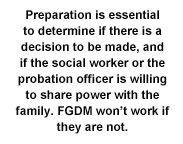 Progress has been slower in juvenile probation, said Lohrbach, adding, “there is no real conferencing being done around youth justice.” Real Justice practice has been murky and blurred, she said, and there are several different [restorative justice] models used in Minnesota in the context of youth justice—from victim offender mediation to circles and restorative conferences. There had been similar confusion in the child welfare area. In 1997, the Minnesota legislature inserted language into the child welfare law about relative (kinship) care agreements and conferences calling for training in mediation skills. Lohrbach said that she and her colleagues succeeded in changing the language to specify FGDM instead. Lohrbach said that she would like to bring youth justice into her unit. “The intent of Ted [Wachtel, of the IIRP] and Lisa [Merkel-Holguin, of American Humane] is to bring the youth justice and child welfare groups together, to untangle the blur that’s happened here,” she said.
Progress has been slower in juvenile probation, said Lohrbach, adding, “there is no real conferencing being done around youth justice.” Real Justice practice has been murky and blurred, she said, and there are several different [restorative justice] models used in Minnesota in the context of youth justice—from victim offender mediation to circles and restorative conferences. There had been similar confusion in the child welfare area. In 1997, the Minnesota legislature inserted language into the child welfare law about relative (kinship) care agreements and conferences calling for training in mediation skills. Lohrbach said that she and her colleagues succeeded in changing the language to specify FGDM instead. Lohrbach said that she would like to bring youth justice into her unit. “The intent of Ted [Wachtel, of the IIRP] and Lisa [Merkel-Holguin, of American Humane] is to bring the youth justice and child welfare groups together, to untangle the blur that’s happened here,” she said.
A parallel justice process is in use in family court, said Lohrbach. Families are now ordered to what is called a Family Case Planning Conference when it has been determined through screening that there is a legal interest in child protection. Cases are brought to a Family Case Planning Conference prior to filing a petition for custody or supervision. The process is completely family-involved, non-exclusionary and non-adversarial: public defenders, lawyers, social service providers and families attend. A guardian ad litem may represent a child. The purpose is to develop the next step for the child. Better than half of these meetings have referred to an FGDM to flesh out a plan, said Lohrbach.
The Etobicoke Family Group Conferencing Project, in Toronto, Ontario, Canada, serves the Toronto metropolitan area. Jeanette Schmid is Coordinator of the program, based at the George Hull Centre for Children and Families. Their website is www.georgehullcentre.on.ca. Schmid joined the FGC project in 1998. The program initially focused exclusively on cases referred from child welfare, but since 2002 it has also incorporated children’s mental health cases. Every FGC, whether for child welfare or child’s mental health concerns, now has two supervisors from two agencies: one from Children’s Aid and one from Children’s Mental Health. The George Hull Centre for Children and Families, the Etobicoke Children’s Centre, the Children’s Aid Society of Toronto (Etobicoke) and the Catholic Children’s Aid Society of Toronto (Etobicoke) collaborated on the FGC project, which was funded by the Children’s Aid Foundation.
To read a report, “Program Design: The Family Group Conferencing Project Etobicoke” go to: www.iirp.edu/article_detail.php?article_id=NDkz.
The project has held 70 FGCs, some repeat, since April 1998. A majority of the children in these conferences returned to kinship care, although not necessarily to the care of their parents. The result was “higher than expected, and borne out by other results obtained internationally” said Schmid. The results were also better than those in cases where FGC was not used, she said. However, said Schmid, it’s important not to define success in FGC as family preservation. More significant is that “the secrecy is ended around certain issues,” and that the extended family is given an opportunity to play a role in ensuring a child’s safety.
Feedback about the program indicates that families appreciate having a voice and that FGC makes families feel closer and more comfortable asking each other for help. Also, said Schmid, FGCs change the way professionals perceive and are perceived by families. Through FGCs, professionals learn that there really are strengths in families and families feel that professionals better understand their issues.
“It takes hard work to increase the pool of referring social workers,” said Schmid, but those who do refer to FGCs find that the process is a respectful way of dealing with people and tend to refer to FGCs again. Agency workers’ heavy case and paperwork loads have affected FGC referrals because of the inaccurate perception that FGCs take more time than conventional processes, said Schmid. Also, deaths that have occurred under Children’s Aid supervision (unrelated to FGC), have made workers afraid refer to FGCs because of the perception—again inaccurate—that sharing power is a risk.
 |
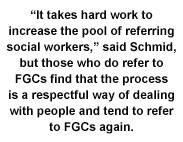 |
The Etobicoke project uses the New Zealand FGC model with minor adaptations, said Schmid. Preparation is critical. With over 150 different ethnic, cultural and language groups, Toronto is the most culturally diverse city in the world, said Schmid. The conference is held in a neutral venue and begins by welcoming everyone with any ritual the family chooses—prayers, songs, Bible readings, animistic libations or tributes to the deceased. After a go-round of introductions, the family shares their hopes for the day and sets guidelines and safety plans for the meeting. Next, professionals present brief reports about the child’s situation and address “bottom line” issues, such as the family’s history of substance abuse and permanence time limits set by the province: one year in government or foster care is permitted for a child under age six, two years for a child over six. There follows a concise discussion of the family’s strengths and concerns. “We don’t brainstorm strengths and concerns like in the California model,” said Schmid. Sometimes, as in the New Zealand model, neutral experts on particular topics, such as grief counselors, are invited to share expertise and answer questions. Halfway through the conference is often the time for a meal break.
The second part, private family time, when the family comes up with a plan for the child, is “sacrosanct,” said Schmid. ‘The only direction I give,” she said, “is to write on their flip chart: Who, What, When, Where, How.” The professionals, including researchers, stay outside the room during private family time. “If family members come out and tell us things aren’t going well, we will work with them and get them to go back inside,” said Schmid.
When the family is ready, it presents the plan to the professionals, who then ask questions. In the past, families felt they were losing control of the process during this part of the meeting, said Schmid, adding, “Workers were doing too much to flesh out the plan.” Now, she said, if necessary, the professionals ask for more detail on the plans, sending the family back into private time. Then the issue of “next steps” is addressed. One third of families ask for a follow-up conference. In a final go-round, all participants say whether or not the process has been useful to them. Schmid delivers a copy of the plan to everyone—families and professionals—within 10 days.
It’s up to children whether or not they attend the conference. For the most part, children of all ages do attend. “With the child present, people stay on the subject at hand—the child,” said Schmid. For children, the conference breaks the secrecy about what’s been happening to them. Although it can be distressing for children to hear about abuse and family problems, it’s also reassuring to hear people talking about plans for their safety and to know that people care about them. Children age four and up are asked what they want the adults to know. The child’s support person, a non-professional chosen by the child to aid him or her throughout the FGC process, can help elicit this information. The conference can be the first time some extended family members meet the child and this in itself can be a very emotional experience. On balance, said Schmid, it’s better for the child to be there.
 There has been no move as yet to incorporate FGC into law in Ontario. Schmid hopes that FGC will soon be officially recognized and financially supported. At the Catholic Children’s Aid Society, an important partner in FGC practice, social workers are now asked as a matter of course whether they’ve thought about using FGC in each case, and if not, why not. Schmid would like to see this as general practice in all child agencies. She believes, however, that FGCs should always be voluntary: “Neither families nor professionals should be coerced.” Still, she thinks that the decision about whether to hold an FGC should not be left only to the parents, but to the family network as a whole.
There has been no move as yet to incorporate FGC into law in Ontario. Schmid hopes that FGC will soon be officially recognized and financially supported. At the Catholic Children’s Aid Society, an important partner in FGC practice, social workers are now asked as a matter of course whether they’ve thought about using FGC in each case, and if not, why not. Schmid would like to see this as general practice in all child agencies. She believes, however, that FGCs should always be voluntary: “Neither families nor professionals should be coerced.” Still, she thinks that the decision about whether to hold an FGC should not be left only to the parents, but to the family network as a whole.
North Carolina, USA has been a center for FGC work. Joan Pennell is professor and director at North Carolina State University Social Work Program and principal investigator of the North Carolina Family-Centered Meetings Project. She and Gale Burford were co-directors of the FGDM Project in Newfoundland, Labrador and New Brunswick, Canada, in the 1990s, which used an adaptation of New Zealand FGC to reduce domestic violence.
In fall, 1998 Pennell began a four-year child welfare project, training families and introducing FGC to North Carolina. Her article about mainstreaming FGC can be read at: http://www.iirp.edu/article_detail.php?article_id=NDky.
“We began by involving communities,” said Pennell. The project kick-off included social services professionals, police, foster parents and others. Community liaisons were chosen to help plan the training and tailor it to each area. Local advisory groups were set up to involve interested people, such as domestic violence counselors and pastors, who were really important, especially in the beginning, said Pennell. Coordinators varied by community, she said, but they were never the same people as those carrying the cases. A statewide advisory committee was formed, including state and county representatives from the Department of Social Services, police, the courts and domestic violence and disabilities agencies, which “gave richness to the discussion,” said Pennell.
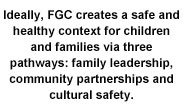 From the start, there was general enthusiasm for the FGC model, although concerns were voiced: Are families articulate enough to express themselves? Will they come? How will social service workers deal with coordinator training? Over time, project managers learned that additional training was needed for social workers, regarding which families to refer to FGCs, how to present family history in a way that families can use it constructively, what to do when children come to conferences or how to handle a conference out of state. The group situations of FGCs can be intimidating for social workers, who are mostly accustomed to one-on-one interactions, said Pennell. Extra by-request training is still on-going. Project evaluation also found a need to monitor plans devised at FGCs or to convene follow-up conferences.
From the start, there was general enthusiasm for the FGC model, although concerns were voiced: Are families articulate enough to express themselves? Will they come? How will social service workers deal with coordinator training? Over time, project managers learned that additional training was needed for social workers, regarding which families to refer to FGCs, how to present family history in a way that families can use it constructively, what to do when children come to conferences or how to handle a conference out of state. The group situations of FGCs can be intimidating for social workers, who are mostly accustomed to one-on-one interactions, said Pennell. Extra by-request training is still on-going. Project evaluation also found a need to monitor plans devised at FGCs or to convene follow-up conferences.
FGCs are in use in North Carolina in two types of child welfare cases: those on the “assessment track,” involving need, neglect or dependency—(80 percent of cases), and those on the “forensic track,” involving abuse and the legal system—the “deep end” cases. Ironically, said Pennell, while professionals are often afraid to make referrals to FGCs from the forensic track, they end up doing it anyway because they don’t know what else to do.
Ideally, FGC creates a safe and healthy context for children and families via three pathways: family leadership, community partnerships and cultural safety. The FGC model should include an independent coordinator, thorough preparation, clear information for families, family private time, a clear process for final plans and a way to integrate plans into “work as usual,” AKA mainstream practice. The last is frequently the toughest piece, said Pennell. Too often, the FGC-devised plan “sits in the file next to the social services plan and the two are never put together,” she said. This problem speaks to a need for sustaining partnerships that make the process work: with the courts, community services and cultural groups. “The family leads the process,” said Pennell, “but it should not be dumped on its own to do it alone.”
 |
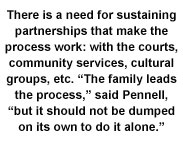 |
Another issue important to Pennell is “cultural safety,” a New Zealand term meaning that a context must be created in which it is safe for the family to express its own social values. Social service workers must be able to relate to different cultures. In North Carolina, for example, meetings often open with prayer or gospel songs.
FGC practice guidance developed for North Carolina based on the New Zealand model has been accepted by the state. North Carolina is now undertaking child welfare reform, looking at an alternative response system similar to that in Minnesota, said Pennell. She is also planning to use FGC in domestic violence cases, via the Safety Conference model, which is in the planning stages.
In California, USA, family group conferencing is widespread. Paul Sivak is a professor of social work at California State University, Stanislaus County, California and coordinator of the Child Welfare Training project. He provides training and support to agencies developing family group conferencing. He is also on advisory committees to the National Center on FGDM of the American Humane Association.
Out of 58 counties in California, 30 are “playing with family conferencing, with different levels of commitment,” said Sivak. In training, Sivak said that he emphasizes “the fundamental values that underpin the various models of family conferencing,” including the two “sacred” elements of “intense pre-meeting work” and private family time, both of which “must be adhered to absolutely.” Any other structure is good, he said, so he trains people in “what works best for them.” Models he uses include everything from FGC, which, he said, employs a “facilitated meeting with a short period of information-sharing,” all the way to a longer facilitated meeting, stressing strengths and concerns.
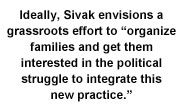 Sivak is leaning toward the FGC model. “Social services people are reasserting themselves” via strengths and concerns, said Sivak, adding, “Many families who have gone through the family conferencing process didn’t have a real family conferencing experience.” All models can be “just as dangerous, unless we shift the value base and build in self-reflection devices,” he said. In Stanislaus County, a pool of 15 – 20 facilitators meets once a month to process their experiences with family conferencing and share successes and failures “with an eye toward going back to the value base,” namely, that the family directs development of the plan for the child and that a partnership grows between social workers and families. Solano County, California is setting up a group, which will include county child welfare workers and community NGOs, to address family conferencing. The 25 “committed folks of the California practitioners’ round-table” meet every three months in various locations around the state to talk out issues related to family group conferencing.
Sivak is leaning toward the FGC model. “Social services people are reasserting themselves” via strengths and concerns, said Sivak, adding, “Many families who have gone through the family conferencing process didn’t have a real family conferencing experience.” All models can be “just as dangerous, unless we shift the value base and build in self-reflection devices,” he said. In Stanislaus County, a pool of 15 – 20 facilitators meets once a month to process their experiences with family conferencing and share successes and failures “with an eye toward going back to the value base,” namely, that the family directs development of the plan for the child and that a partnership grows between social workers and families. Solano County, California is setting up a group, which will include county child welfare workers and community NGOs, to address family conferencing. The 25 “committed folks of the California practitioners’ round-table” meet every three months in various locations around the state to talk out issues related to family group conferencing.
Sivak would like to see the families themselves included in these groups. Groups of families have been meeting on their own to share their experiences with family group conferences and with Child Protective Services. There have also been similar meetings that include both families and social service providers. During the first joint meetings, the professionals were “incredibly defensive” because they’d never perceived themselves as equals of families, said Sivak. “The family-only meetings were very loud and full of laughter,” he said. The last two joint family and professional meetings were also full of laughter but it took community building to get to that point, said Sivak. Family group conferencing must be seen as a long-term community builder, he said.
 |
 |
Ideally, Sivak envisions a grassroots effort to “organize families and get them interested in the political struggle to integrate this new practice.” To that end, he is implementing a long-term “participatory research” project with families. “Our research is based on tools generated by families,” he said, adding, “Families tell us what we should measure and what questions to ask.” Through facilitated focus groups, Sivak has found that families are interested in the change of the nature of relationships inside the family and “the quality of well-being.” Research questions that families would ask include “does the family network really feel that they share responsibility for the child?” and “would you rather handle problems as a group or as an individual?”
Family members, not social workers or professional researchers, are now conducting the research interviews, although not necessarily within their own families. The process may be more time consuming, said Sivak but the end result is “data that’s more rich and more reliable.” Families, “totally uncoaxed” realize that research can be a tool for social change, not just a measurement, and that documentation is power. The non-dominance-based partnership of family conferencing evokes a power that touches a natural part of us, he said. “Restorative practices and family conferencing have the same goal,” said Sivak: rebuilding community and returning healing and decision-making power to people.
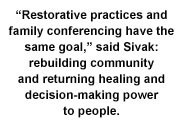 Sivak believes that family conferencing must always be voluntary. The California practitioners group is lobbying to short-circuit a move by the state that would require family group conferencing. He would rather see government departments obliged to educate providers about the practice so that they would be prepared, rather than required, to provide it. Said Sivak, “The argument that the ends justify the means is always wrong.”
Sivak believes that family conferencing must always be voluntary. The California practitioners group is lobbying to short-circuit a move by the state that would require family group conferencing. He would rather see government departments obliged to educate providers about the practice so that they would be prepared, rather than required, to provide it. Said Sivak, “The argument that the ends justify the means is always wrong.”
Vermont, USA has long been the location of many FGC and restorative justice programs. Gale Burford is professor and Director of the State Child Welfare Training Partnership at the University of Vermont Department of Social Work. As previously mentioned, he and Joan Pennell were co-directors of the Family Group Decision Making Project in Newfoundland, Labrador and New Brunswick, Canada, in the 1990s.
Burford has several projects in proposal stage. He is planning an FGC demonstration project in 2003 to bring adult corrections and child welfare personnel together to examine how families overlap with one another in both agencies. But Burford is concerned that “new language” may be needed for the project because “the term family group conferencing sets off so many fusillades. People hear the word conferencing and they think it’s recklessly putting victims where perpetrators will be able to control them.” He thinks it might be safer to talk about “community-based empowerment.”
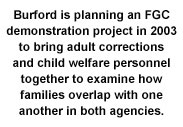 Burford is definitely an FGC enthusiast. “It contains everything I believe about how we get to lasting solutions,” he said, adding, “Everything tells us that the way to get the best results is to engage the person and members of their family and FGC is one of the only models around that satisfies the criteria.” But, he said, “It creates so much fear and opposition.”
Burford is definitely an FGC enthusiast. “It contains everything I believe about how we get to lasting solutions,” he said, adding, “Everything tells us that the way to get the best results is to engage the person and members of their family and FGC is one of the only models around that satisfies the criteria.” But, he said, “It creates so much fear and opposition.”
Asked the reasons for the fear and opposition, Burford said that his “harshest theory” posits a “deep, enduring mistrust of groups getting out of control, which can be traced right back to the McCarthy era. People doing this kind of thing were thought to be communists or socialists.” (Joseph McCarthy was a United States senator in the 1950s who spearheaded a relentless anti-Communist crusade.) Also, said Burford, FGC practices threaten professionals, positions and power and child welfare professionals are afraid they will be blamed if something goes wrong. “And they do get blamed,” said Burford. He cited the “gut-wrenching and sickening” case of Victoria Climbie, a little African girl who was tortured and killed in the UK In the aftermath, he said: “People were falling all over themselves with procedures, instead of working with people. A mountain of new procedures was developed, which simply created more ways for families to be excluded.”
There’s a pattern in the US, said Burford: Professionals give lip service to the notions of self-help and mutual aid, but then don’t refer to conferences. It’s the same thing in Sweden and the UK, he said. He cited a Swedish study that interviewed professional people, all of whom thought conferencing was a great idea but “within 18 months less than one-half or one-third had referred families” to the practice. Burford also discussed a Vermont FGC project of several years ago that he regards as an implementation failure. “Families loved it, coordinators loved it,” he said, but the government and NGO partnerships which had made it possible came undone. They dissolved the project despite the report confirming that families loved it. The problem, said Burford, is that there’s no legislation to back up such programs, so they can’t last. “Pockets of real enthusiasm are keeping them alive in different places, but once they diminish they start to lose steam.” In North America, he said, “where everything is so fickle with financing, if we don’t enshrine it in law, it’s gone.”
Burford reported on results of the on-line FGC survey he and Paul Nixon ran via the American Humane Association’s website. Over 200 responses were received, addressing how projects started, what obstacles people encountered and what had made the projects possible. “It was the same all over,” he said, “Practice is under threat of financial whims.” He contrasted this situation with that in New Zealand, where families have a right to the FGC process. On the other hand, wondered Burford, if government-sponsored programs dilute or corrupt practice, “are we better off skating along the margins?” He referred to an FGC training video produced by one the state governments in the US that showed a social worker inappropriately influencing the conference by sternly advising a family: “Your job is to decide which one of you takes this child home.” Added Burford, “Ted [Wachtel] has the right idea: develop strong national connections and build organizations to keep things going without politicians’ support. That’s hugely democratic.”
Asked how to help FGC programs endure, Burford said, “We have to move on a lot of fronts at once,” on the local and legislative levels and through education. As an example of success on the grassroots, local front, Burford cited the 1990s FGC domestic violence project in Newfoundland and Labrador: “We ran 10 conferences among 1600 people with 12 to 18 people in each. That’s not very many conferences before you have the entire community involved. That’s a revolution!”
As for legislation, Burford said that FGC practice and philosophy ought to be enshrined in law in “minimalist language,” e.g.: the family has the right be at all meetings where their situation is discussed; the state has the obligation to ensure support for families in getting to the meetings; there must be the opportunity to caucus without undue professional influence; support must be provided to carry out the family’s plan.
 |
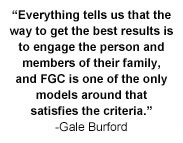 |
One of the biggest challenges to FGC is funding the plan, said Burford. But blocks to funding among various agencies and organizations usually “turn out to be things they’ve invented themselves.” Said Burford, “If we can go into an organization and get people together, we can figure it out.”
Concerning education, Burford said, “We have to get our feet into professional training programs and transform the brains of professionals. They’re the ones who are giving us the most trouble.” Social workers, psychologists and psychiatrists need to understand that FGC won’t harm vulnerable people, he said, and that FGC is the best way to honor people’s rights and consider the well-being of the community.
Burford concluded: “We must seize the ball soon while we have agreement on the left and the right or we will miss the opportunity.” In the US for the past decade, he said, an unlikely combination of people on the far-right and moderate-left has come to agree on certain principles. The right is saying to the left: “We are happy to hear that you no longer need to throw billions of dollars at welfare.” The left is saying to the right: “We’re glad you’re in favor of empowerment and community.” FGC appeals to a wide spectrum, said Burford, both “the family values crowd on the right and the empowerment people on the left.”
Author’s note: I want to thank the fascinating and dedicated people who kindly agreed to an interview with me during the past several months regarding family group conferencing. Everyone one I spoke with—from Finland to Australia—was excited about the power of the process and their enthusiasm was infectious. And although each person might not have agreed on all the finer points of language and methodology, all shared the underlying conviction that people and their families and friends are best equipped to make decisions about each other’s care and support. This belief is deeply democratic and it includes everyone: small children, the elderly, those who have been categorized as delinquent or mentally ill. I was profoundly moved by stories of how people’s lives were changed by the process. And I was encouraged to hear that practitioners and proponents of all the approaches are realizing that they are working toward the same goal: building a global alliance for family empowerment and restoring community in a disconnected world.
The Restorative Practices eForum will continue to feature FGC programs in the future. An article to be published soon will discuss FGC programs in child welfare, domestic violence, education and youth justice in Hampshire County, UK.

Restorative Works Year in Review 2023 (PDF)
All our donors are acknowledged annually in Restorative Works.
